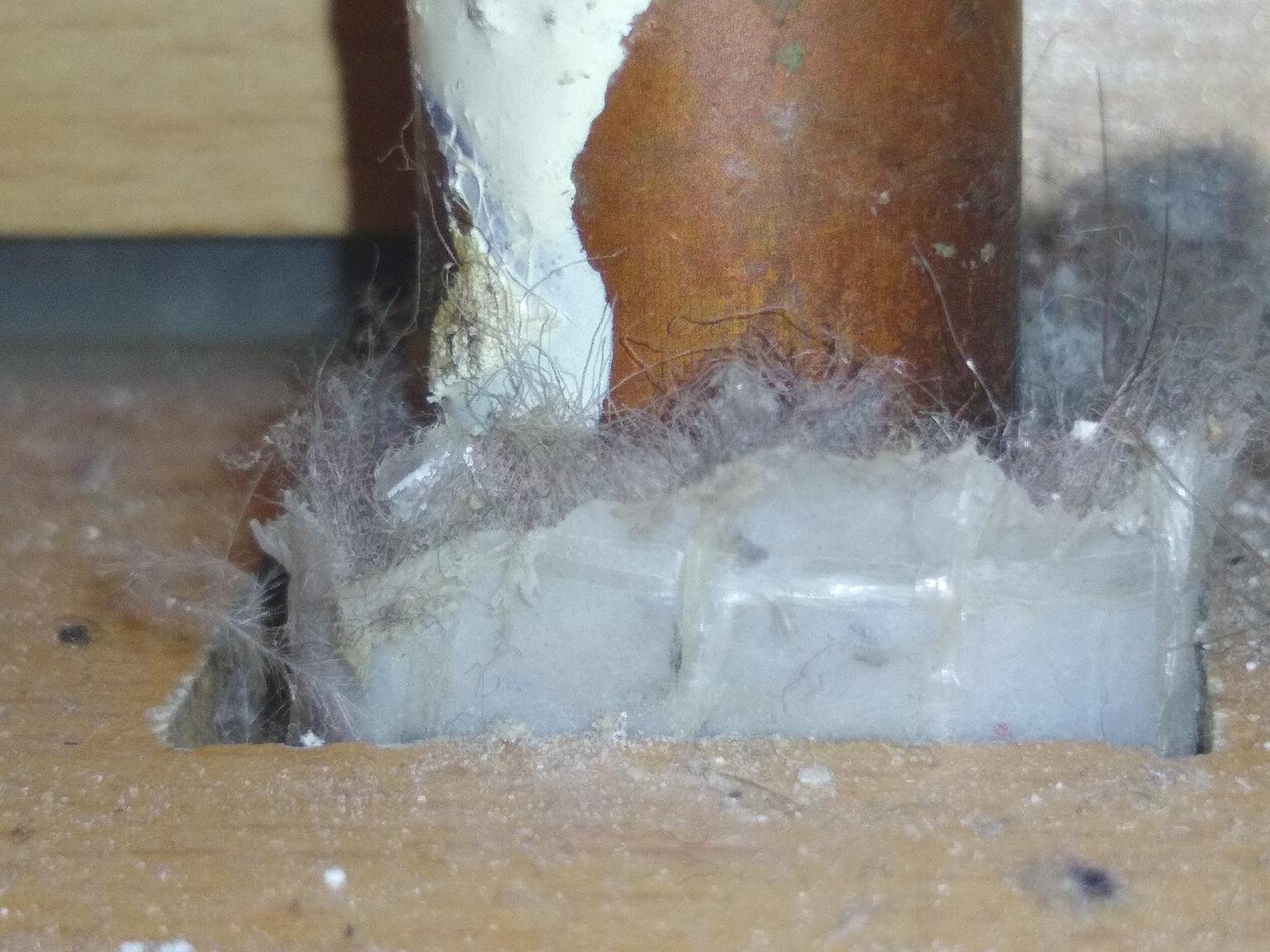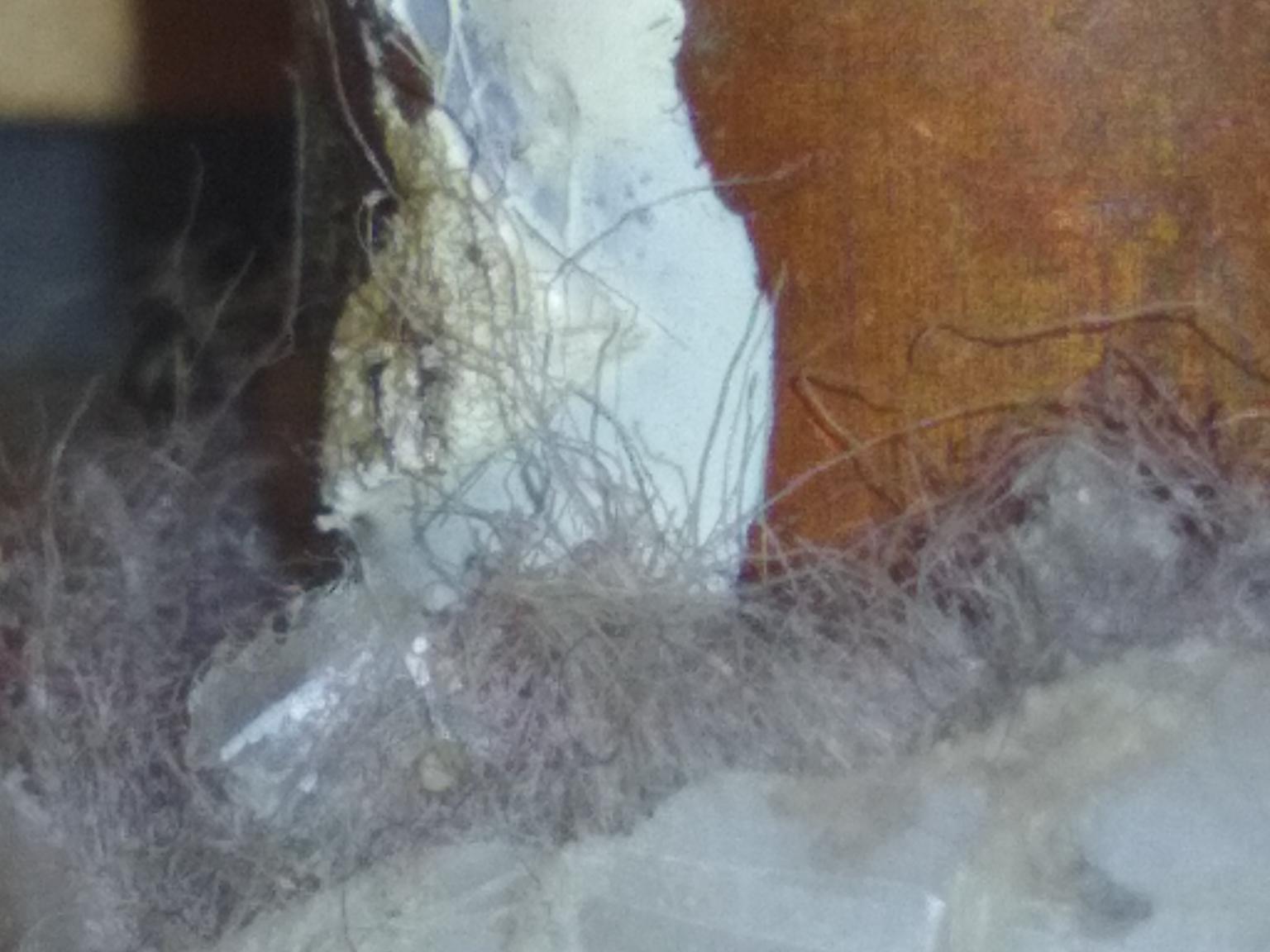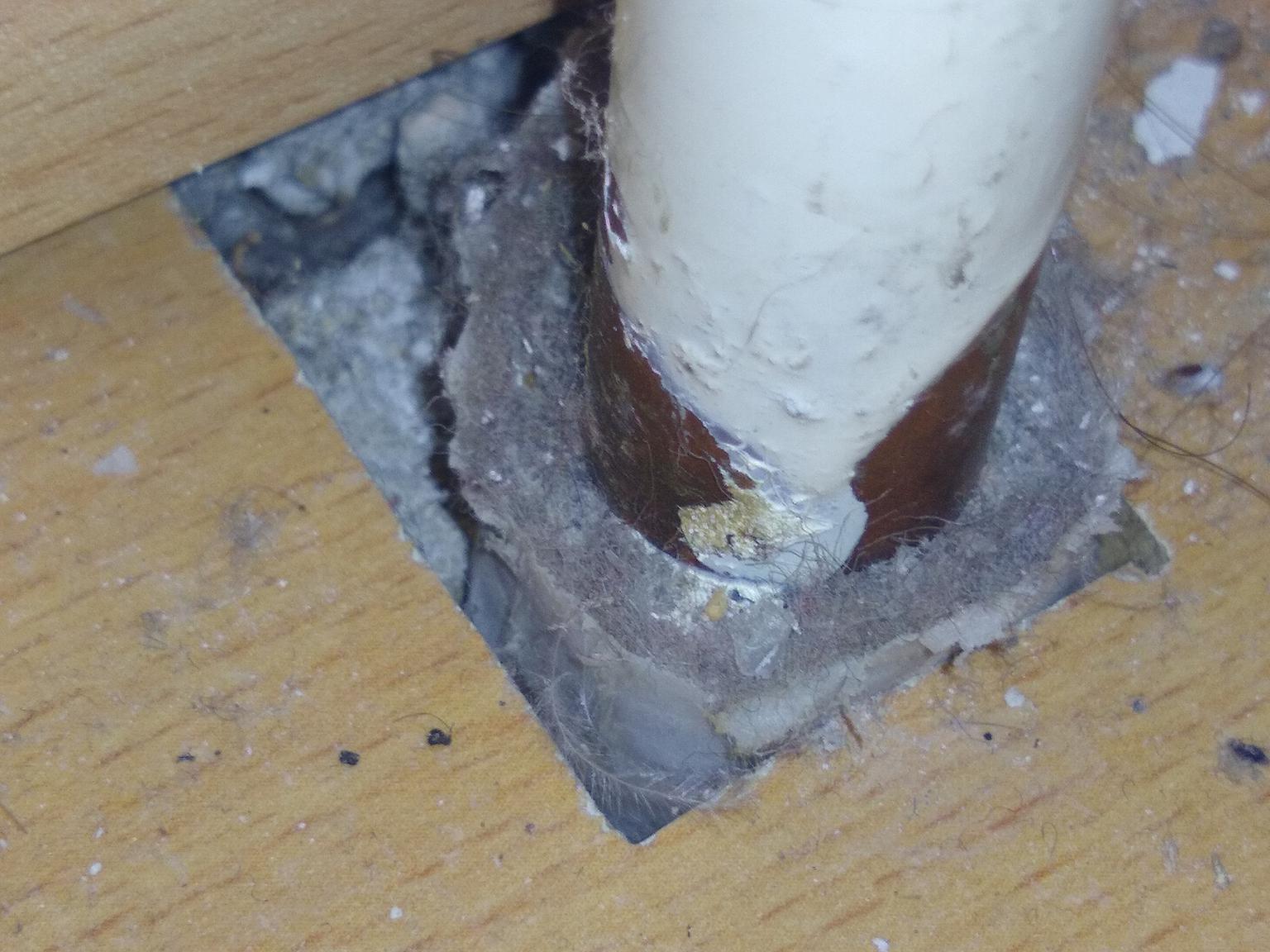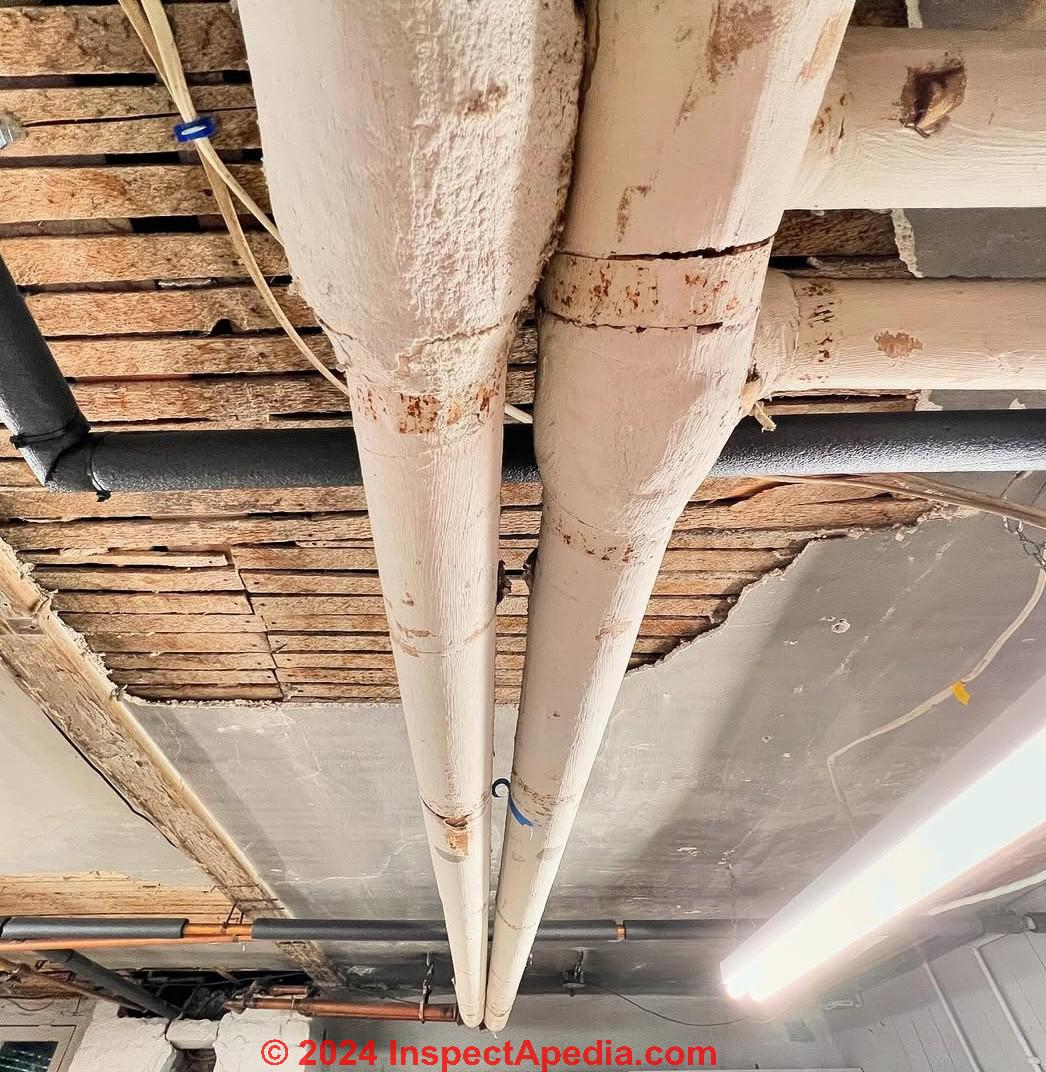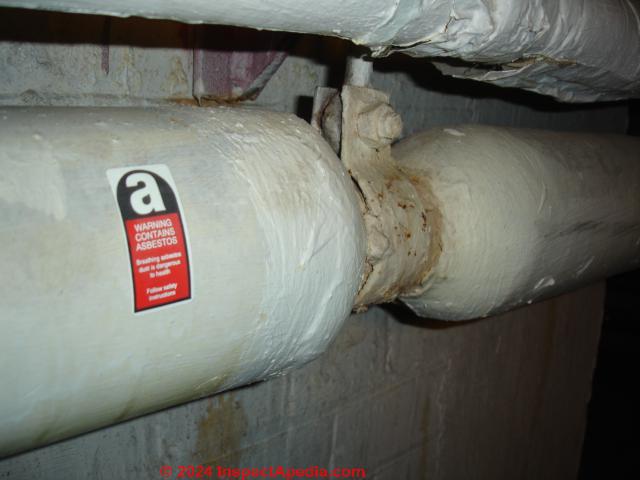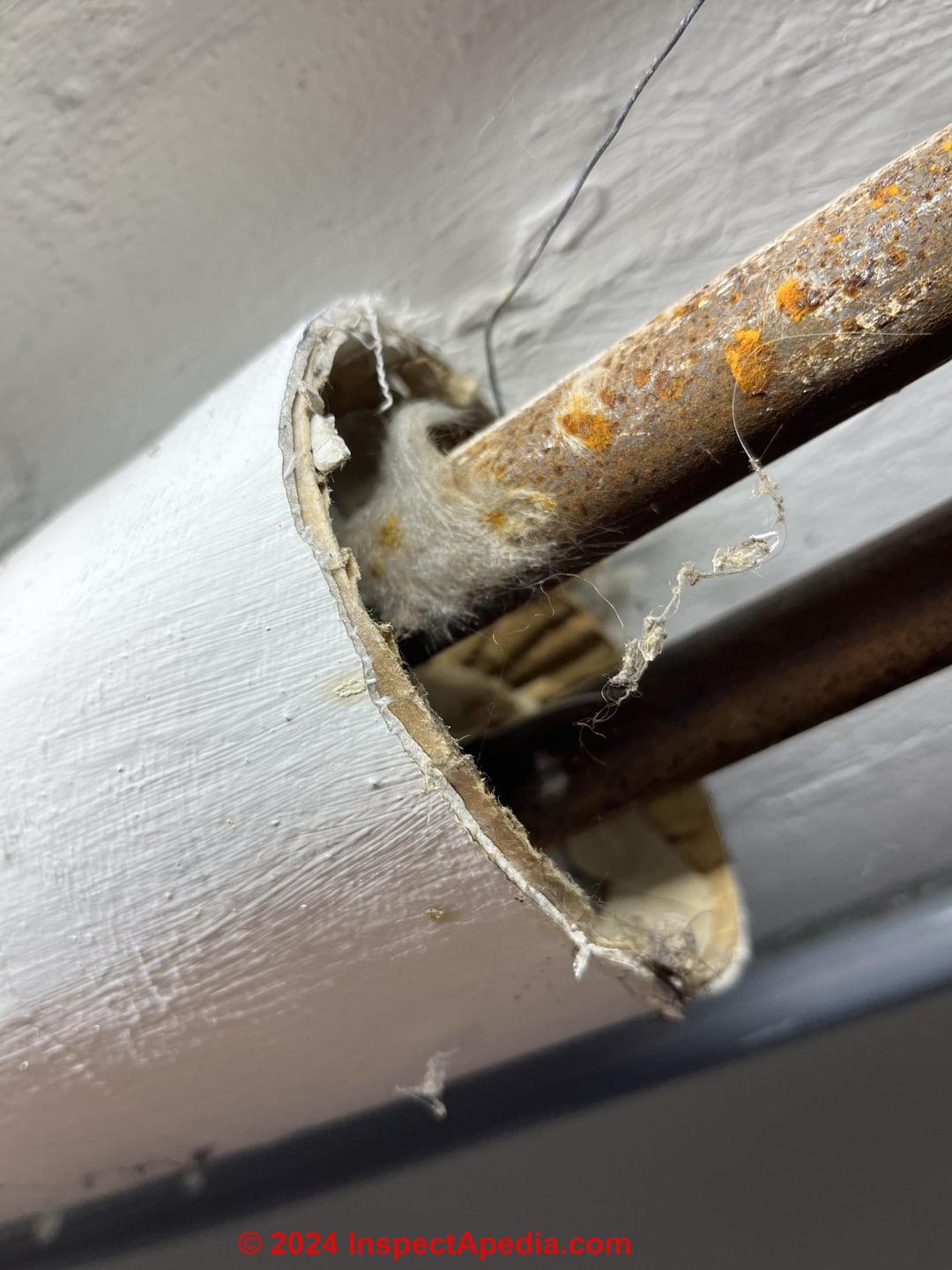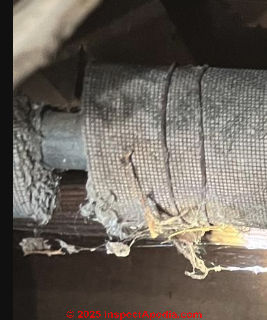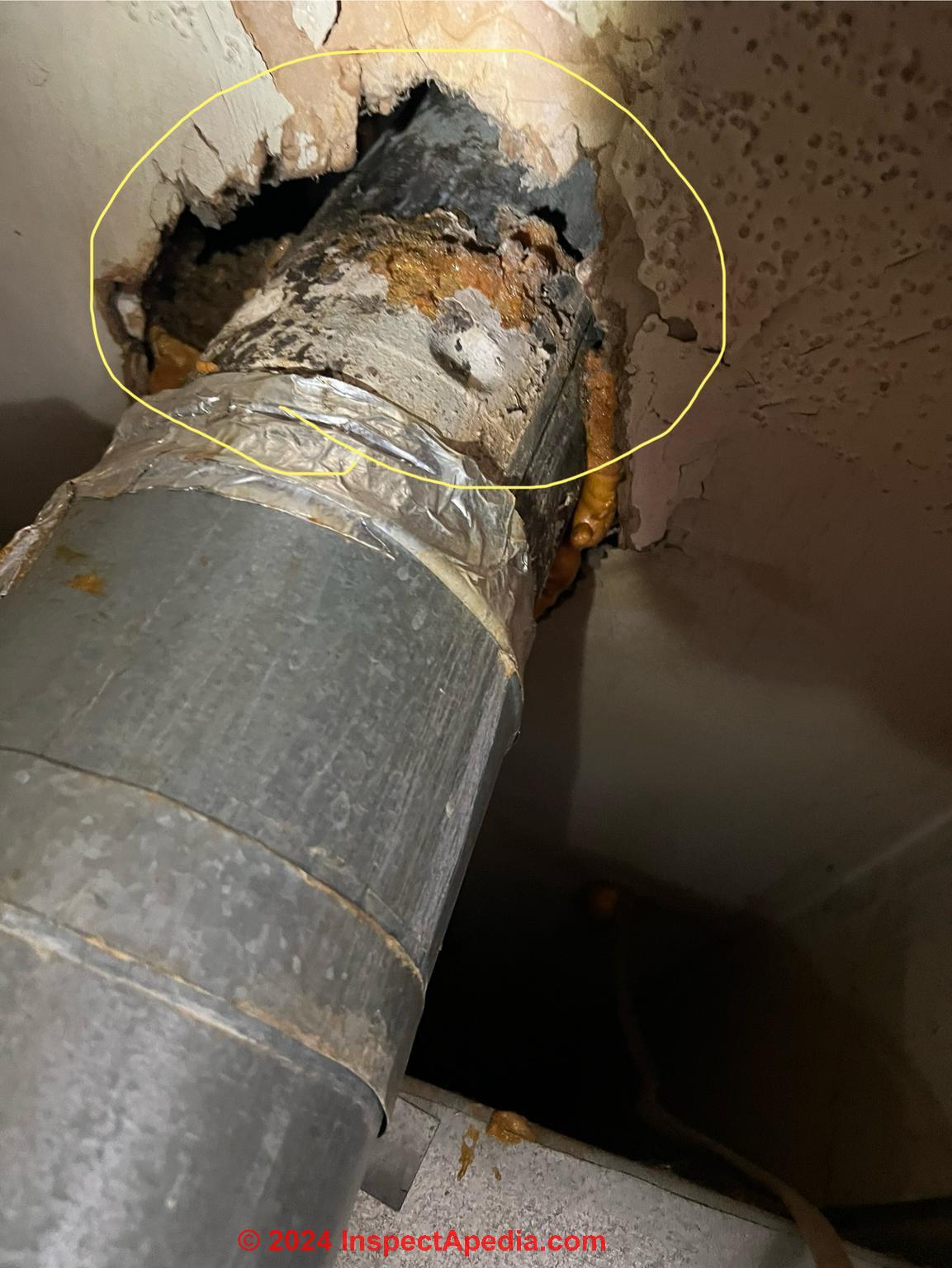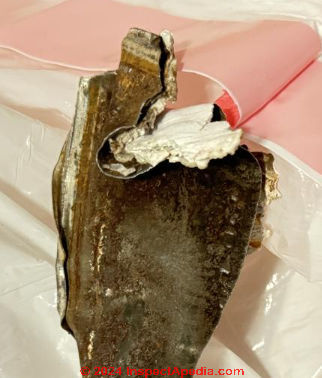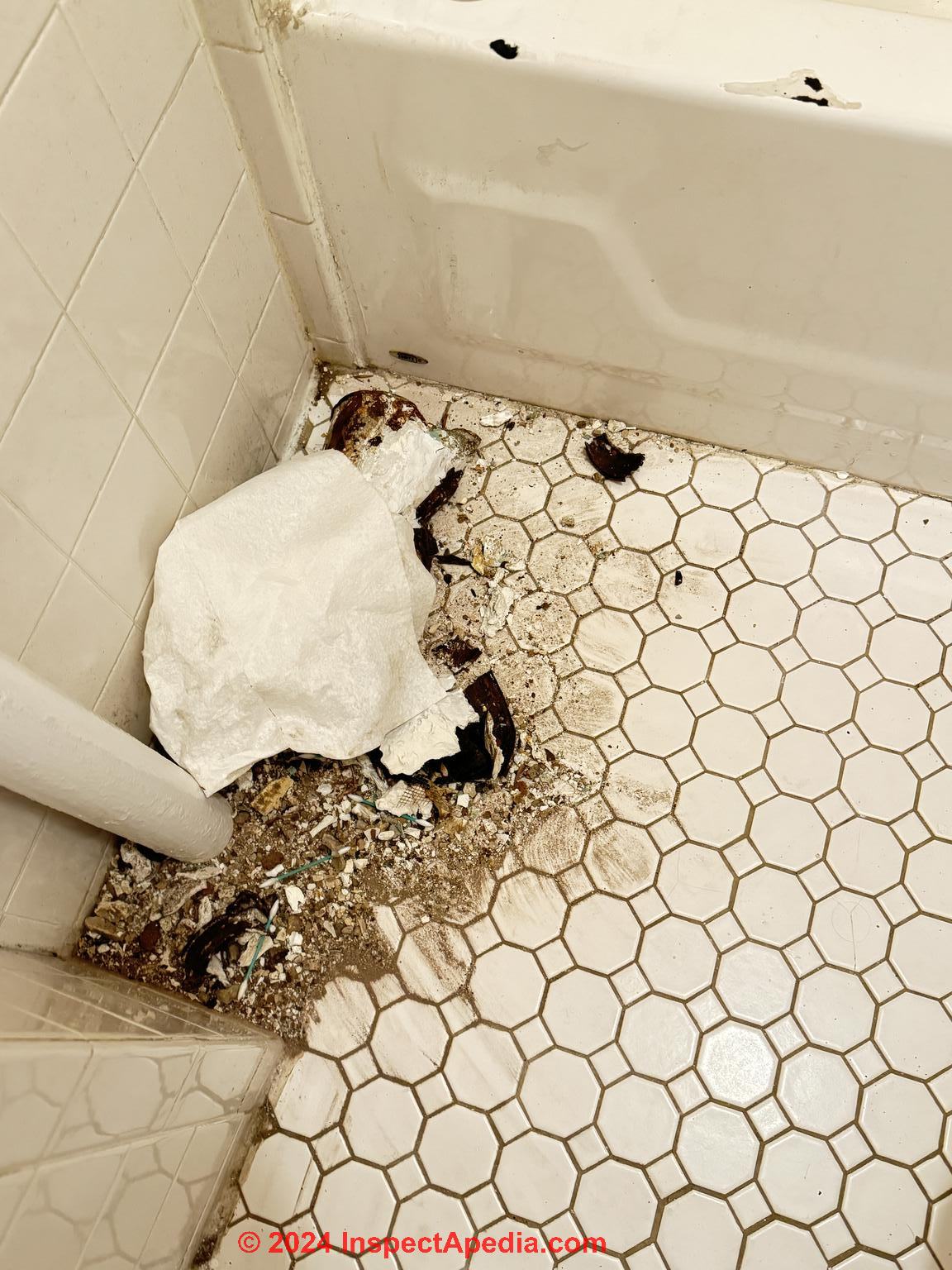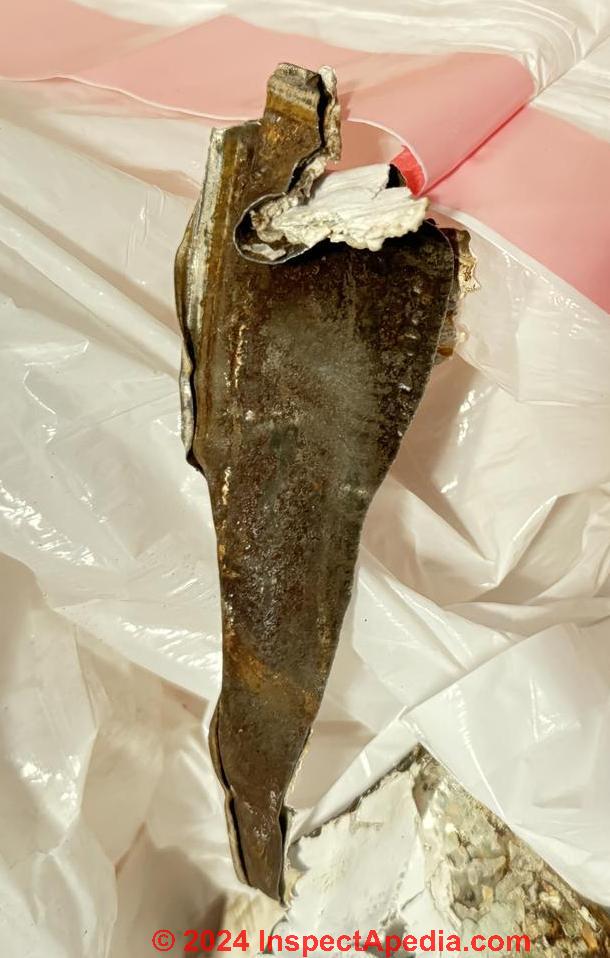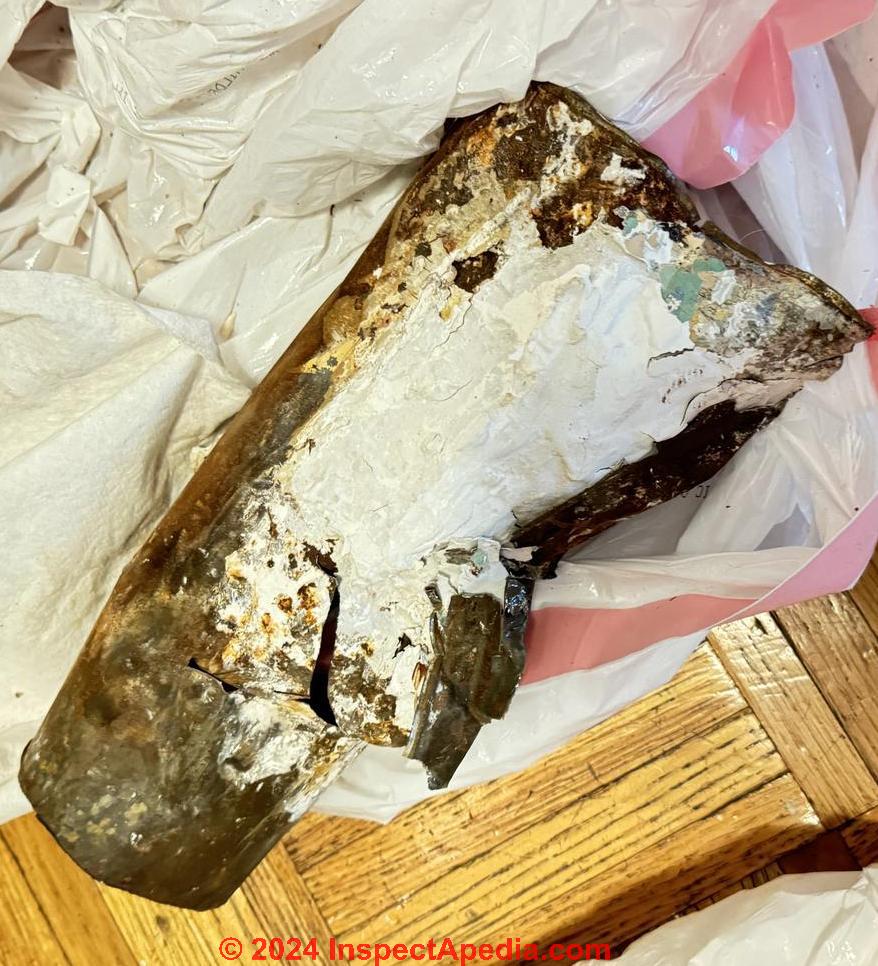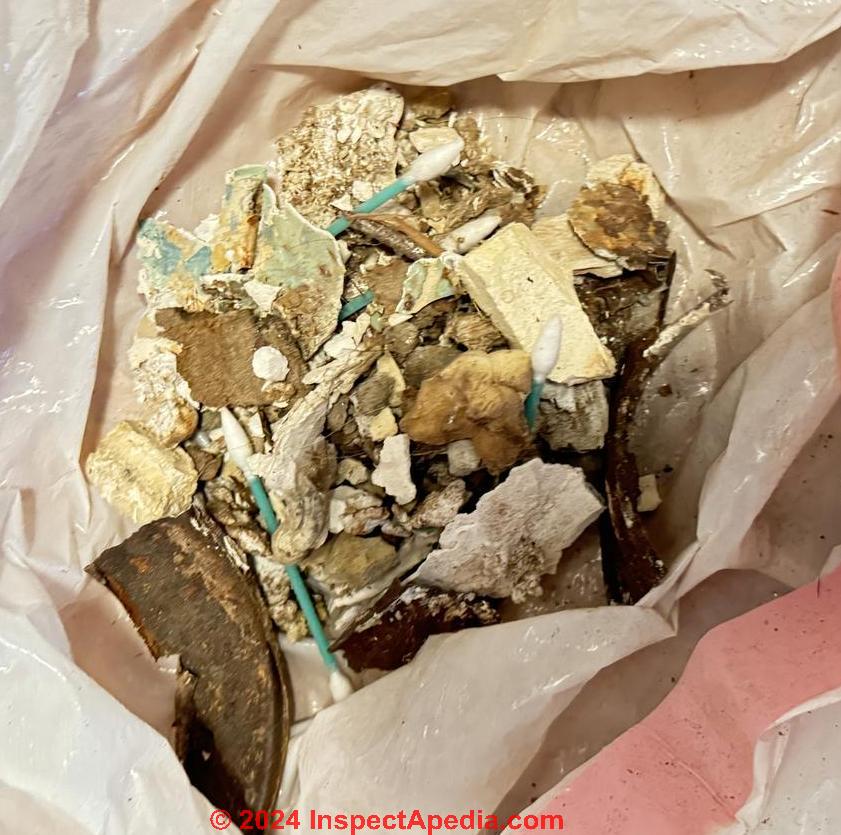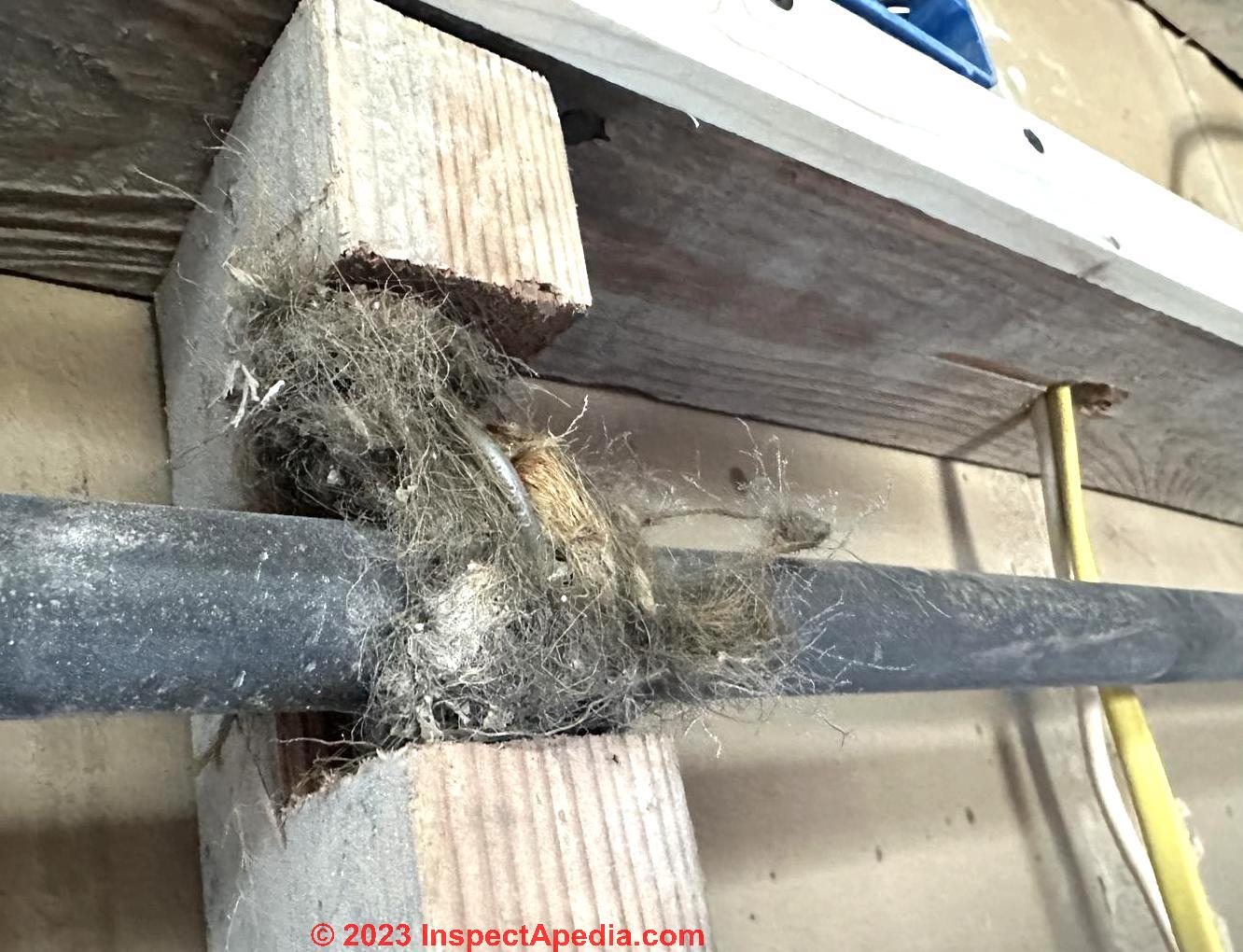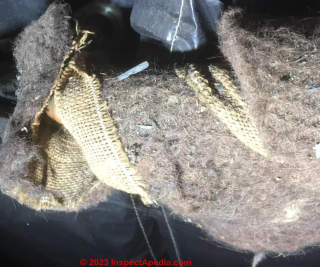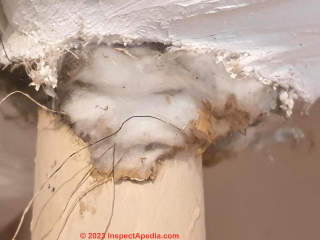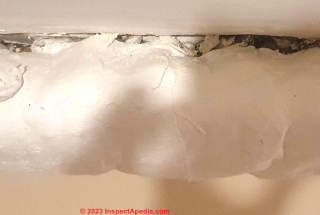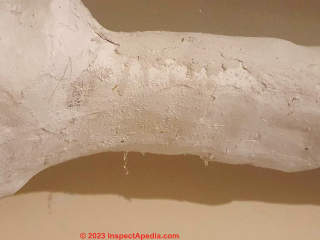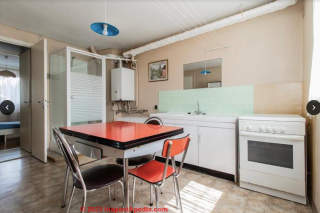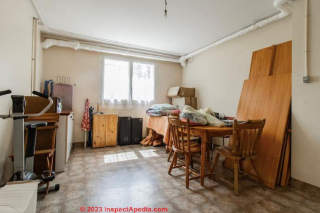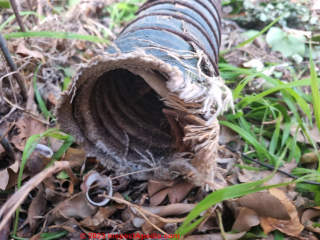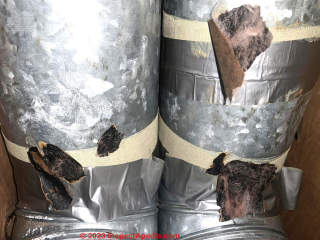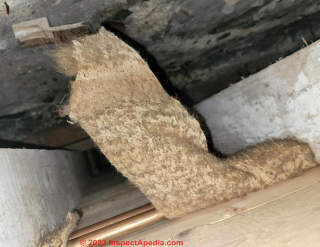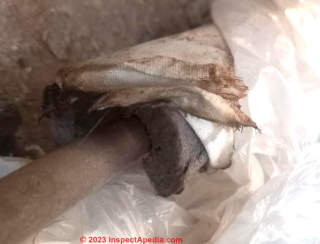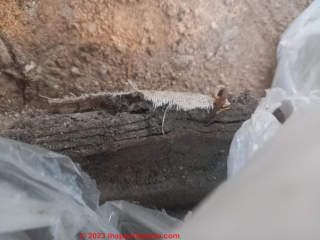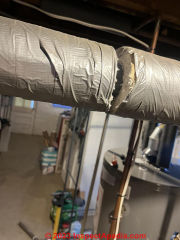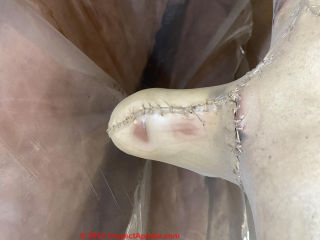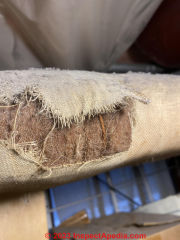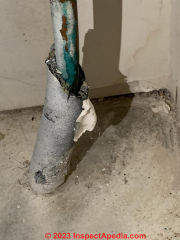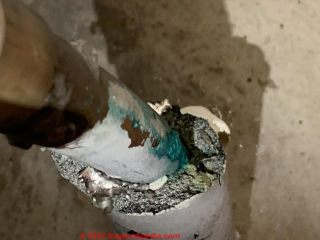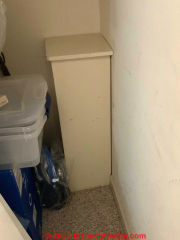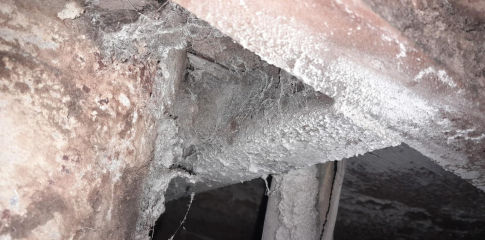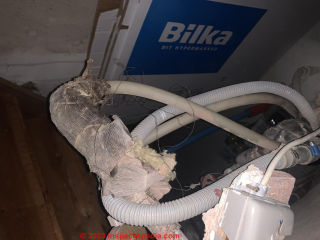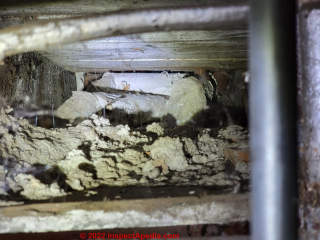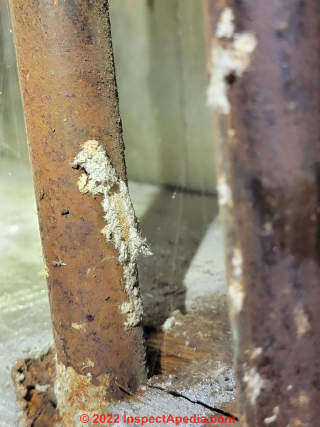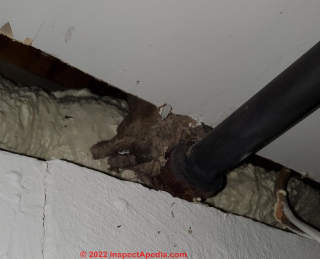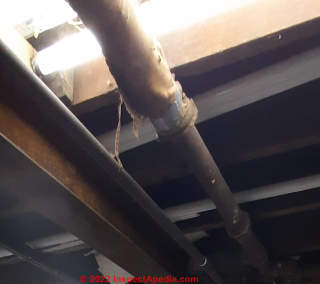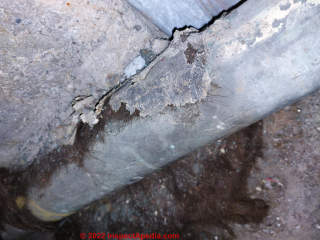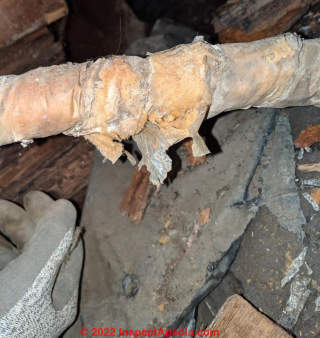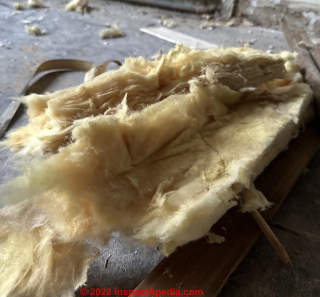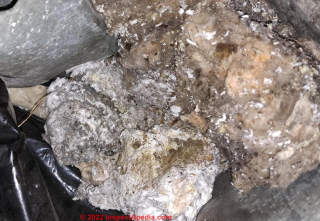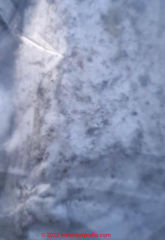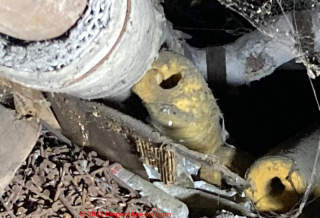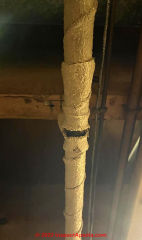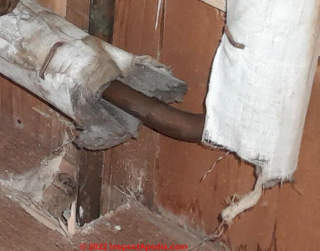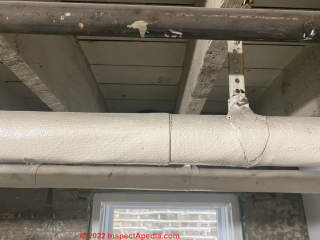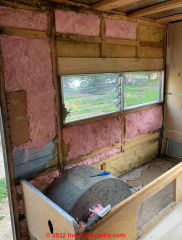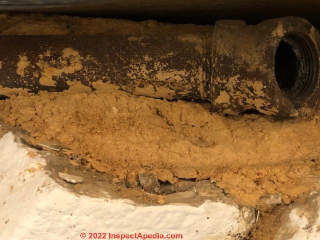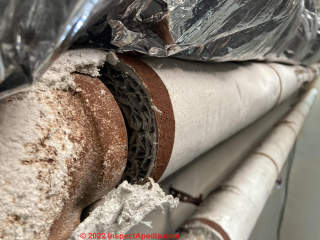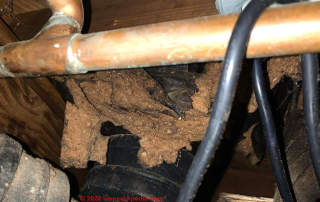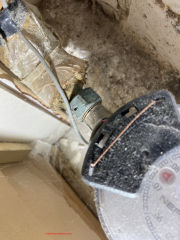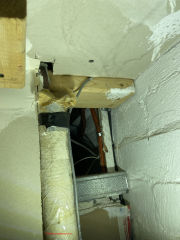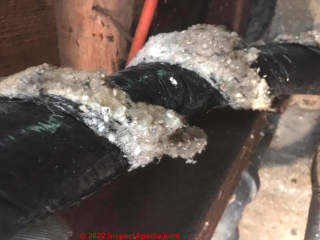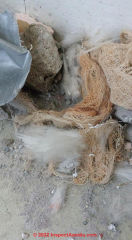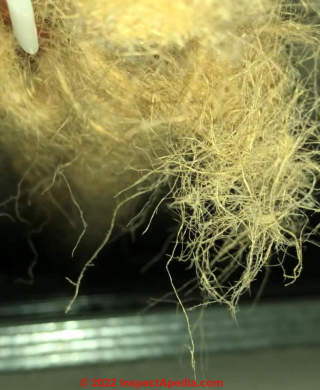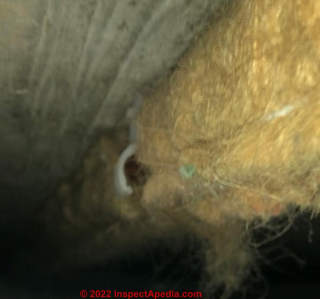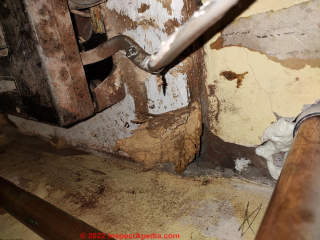 Asbestos Pipe Insulation FAQs #3
Asbestos Pipe Insulation FAQs #3
Recent FAQs on asbestos insulation on pipes: recognize & take action
- POST a QUESTION or COMMENT about asbestos-containing pipe insulation: identification, encapsulation, or removal
Q&A about asbestos pipe insulation in buildings set #3.
Recent FAQs about how to recognize asbestos insulation on heating or water pipes and what to do about it.
This article series provides photographs of abandoned and partly-covered-up asbestos pipe insulation in buildings to assist in the recognition of that material.
InspectAPedia tolerates no conflicts of interest. We have no relationship with advertisers, products, or services discussed at this website.
- Daniel Friedman, Publisher/Editor/Author - See WHO ARE WE?
Questions & answers on Asbestos pipe insulation
 These questions & answers or comments about asbestos-containing pipe insulation and asbestos pipe insulation removal and disposal procedures and costs were posted originally
These questions & answers or comments about asbestos-containing pipe insulation and asbestos pipe insulation removal and disposal procedures and costs were posted originally
at ASBESTOS PIPE INSULATION - be sure to read that article.
Watch out: asbestos pipe inslulation in good condition is usually best left alone or encapsulated: left alone, in place, undisturbed, risks and costs are minimized. But if asbestos pipe insulation is in poor condition, shedding, damaged, falling-off, or if it is in a location where it is likely to be damaged, it should be removed and the pipes cleaned and sealed.
For asbestos pipe insulation that is in poor condition, falling off it is beyond encapsulation and needs to be removed by a professional.
This article series assists building buyers, owners or inspectors who need to identify asbestos materials (or probable-asbestos) in buildings by simple visual inspection.
Photo: corrugated asbestos paper on a roof drain pipe in a commercial building.
[Click to enlarge any image]
Gray fibrous pipe insulation in Germany
Hello Daniel,
do you have any idea what kind of heat pipe insulation this might be? For scale, the pipe's diameter in that picture is about 1 cm so the picture is zoomed in alot. The date of construction is 1990/1991 and the location is Germany.
Thanks alot. 2025-04-17 by Martin
...
...
...
Reply:
@Martin,
Thank you, that's a very interesting pipe insulation photo and material. It looks like a plant-based fiber, but I'm not sure which plant.
If you zoom in for a close view at the left edge the structure looks almost feather like. Of course it's not going to be feathers. But it certainly is an argument against any concern you might have for asbestos.
Daniel FriedmanFollow up:
Hello Daniel,
Thank you very much for your reply. As for the feather, I think it may just be from a pillow or blanket because there is a bed in the room. The pipe is a little difficult to reach because there is a desk in front of it and so that spot is rarely cleaned.
I have spent a lot of time looking at various pictures of pipe insulation and insulation in general but nothing really looks like it. Fibre glass comes closest but I'm not at all sure that is it.Reply:
@Martin,
Continuing:
I've asked SA-Dynamics in Germany (Website: https://www.sa-dynamics.com/ ) if they recognize this insulation and I sent them your first photo.
Also, Because they cited that German start-up company, SA-Dynamics as a vendor of bio-based aerogel insulation and as they provide some plant-based fibre insulation materials we've asked an Indian company, Fibre2Fashion (at www.fibre2fashion.com/news/textile-news/german-start-up-sa-dynamics-introduces-bio-based-aerogel-insulation-294659-newsdetails.htm), if they can help us identify this material.
I'm continuing to research your question.
Daniel FriedmanMore reply:
@Martin,
I agree that this looks like a mineral-based fibre (excluding now the feather); fiberglass or mineral wool; I've surveyed the mineral wool pipe insulation from Knauf, BASF, and other companies - a few are gray in color but all of them look more dense and most are yellowish.
Still looking. If you see a label or any imprint anywhere let me know. Also helpful, if you're in Germany, would be to check with local plumbing or insulation companies - installers - as one of them, if still in business, surely installed this material and will know exactly where they got it.
DFFollow up:
Hello Daniel,
Thanks so much for all of your help, that is really kind of you.Reply:
@Martin,
We are glad to help. Researching questions like this may also be helpful to others. We're hanging on as long as we can but unfortunately Google's search algorithm has decided that our website is best replaced by their AI.
Daniel Friedman
Is this asbestos insulation encapsulated?
Is this asbestos insulation encapsulated? It doesn't looks like one, and it doesn't appear to be like a paper or anything soft? 2025-02-05 by Anonymous
Reply:
@Anonymous,
At this point my best advice is that you hire and asbestos testing or environmental testing company to have appropriate samples of the material tested and to give you a written report. Just from looking at your photos there's not more certain analysis that one can provide.
Daniel Friedman
Is this encapsulation?
Is this encapsulation? 2025-02-04 by Anonymous
Reply:
@Anonymous,
It looks like it. I would certainly like to see a sharper photo of that label so that I can read all of its text.
It would be appropriate for an asbestos encapsulation company to affix a warning label onto a cover.
Daniel FriedmanFollow up:
@InspectApedia Publisher, is there always a warning sign on asbestos encapsulation? Is this often see in commercial settings while residential might not?
Reply:
@Anonymous,
No
Why does the white outer layer looked like it has been painted?
Is this asbestos? Why is the white outer layer looked like it has been painted? Is it encapsulation? BTW this is in Germany, do we have anything like this? 2025-01-30 by Anonymous
Reply:
@Anonymous,
That inner yellow fibrous material looks like fiberglass to me. What's unclear is the thicker white exterior coating. If that's simply paint or multiple layers of paint you would not expect that to contain asbestos either.
DanielFollow up:
@InspectApedia DF, do we see these paint on asbestos pipe insulation like corrugated ones in US? This is in Germany, so I am assuming we won't see the same in US.
Reply:
@Anonymous,
I haven't seen that exact pipe installation in the US but of course it's possible. No one person's view is exhaustive.
It would be quite odd however to have used an asbestos coating on top of fiberglass which is already an insulating material.
DanielFollow up:
@InspectApedia Publisher, I mean my questions was, do we often see simply just paintings on asbestos pipe insulation?
1926 summer home in Inverness, CA pipe insulation
Wondering what this insulation is and hoping it is something safe. House was built in 1926 as summer home in Inverness, CA and added on to over time. Details of dates for work are unknown. This image is of pipe wrapped in insulation beneath the living room floor in sub area. 2025-01-06 by S.H.
Reply:
@S.H.,
Looking at the (not quite in focus) fibrous ends exposed at the left in your photo I think I'm seeing what looks like mineral wool or a similar material.
Please compare what you see on your pipe with the asbestos pipe insulation shown at the top of this page.
And if you can post a sharper photo of the exposed ends of insulation at that gap on the pipe covering, that'd be helpful.
Daniel F
ACM wrap above tape?
ACM wrap above tape? 2024-12-08 by Sam
Reply:
@Sam,
Good eye. That does look to me like it could well have been an asbestos paper wrap.
Nothing to panic about but don't make it into dust. You could paint it or you could encapsulate it.
Debris from pipe insulation repair
Hi. I live in a building that was built sometime between 1894 and 1900 in NYC. I needed a hole in my ceiling around a pipe and the hole in the wall behind the pipe fixed.
I was told the issue was the piece at the top of the pipe. Two supers didn't want to touch it wouldn't say why. I asked a super in the neighborhood and he said he thinks it is Asbestos.
I asked my building management company to have it tested. Instead they were in a rush to have the piece of pipe removed immediately told me I didn't have a choice.
They took it down without testing and here are the pics of before after and what came off.. Do you think it is asbestos and should I take to a lab to have it tested? 2024-10-09 by Kate
...
...
...
...
...
...
Reply:
@Kate,
I've looked at your photos on a larger screen in higher resolution to see what I could make out in the debris of what was removed around that pipe at the ceiling. The material look to me like mostly plaster and a mix of cotton swabs (Q-tips) and paint. One or two small pieces *might* have been corrugated asbestos insulating paper - but it's uncertain. (See my snapshot of a bit of one of your photos, below.)
Compare the material you found with the gray-white corrugated paper-like asbestos pipe wrap shown at the top of this page. I couldn't find anything in your debris that matched that.
My OPINION, based on the location and volume of material is that the money you'd spend on asbestos testing would be better-spent simply on thorough cleaning of the bath ceiling, walls, and floor in this area - treating the debris as "PACM" or "Presumed Asbestos Containing Material".
That means damp-wiping the surfaces or if you prefer, using a HEPA-rated vacuum cleaner to remove any remaining dust nearby.
That opinion is based on the view that the total amount of debris was very small, the area one of hard surfaces that are easy to clean, and erring on the side of caution.
There is nothing here to panic about, but cleaning would be appropriate.On 2024-11-09 by Absolute Asbestos Services
@Kate, definitely have that tested. In my state, if the area is over one square foot, removal must be performed by a certified professional and only after testing has been conducted. I'm sure NY laws are strict any disturbance should only be after testing
Reader follow up:
@Absolute Asbestos Services, the portion seems covered in paste like paint, was it encapsulated?
Is this asbestos pipe lagging?
Hi, is it possible that this could be asbestos pipe lagging? I believe the building could be from 1950's.
Thanks. 2024-08-23 by Taylor
Reply:
@Taylor,
That looks to me like white fiberglass or cotton. To be clear, nothing in your photo looks like asbestos pipe insulation.
Coprolite asbestos
Coprolite (blue asbestos)
was used in spray-on insulating coatings such as on boilers, steam engines, and sometimes as heating or other pipe insulation. This is an amphibology (needle-shaped fiber) asbestos that is particularly hazardous
Did you mean that when this was used as heating and other pipe insulation it was in the form of spray-on insulating coating? 2024-05-11 by Anonymous
Reply:
@Anonymous,
Under the aegis of thoroughness, we reported on coprolite asbestos
use a spray-on boiler insulation based on some research that reported that application.
However that would be very uncommon and probably virtually never found on residential heating systems. The common boiler insulation that we found was more cementious and similar to the lagging used on pipe elbows, valves and other irregular shapes. It doesn't appear to have been sprayed on but rather troweled on.
And I have found no indication, report or other evidence that a spray on insulation was used on residential heating system pipes themselves.
The most common asbestos type pipe insulation are shown at the top of this page, it was a corrugated asbestos paper.
I'll do some further research to see what else we can find on this question.It's worth noting that the more common use of the word coprolite refers not to a form of asbestos but rather to fossilized animal feces. A quick look in the Encyclopedia Britannica finds
"Coprolite, the fossilized excrement of animals. The English geologist William Buckland coined the term in 1835 ...". - https://www.britannica.com/science/coprolite
Worried about asbestos on pipes at Stonybrook, New York
At my university, some small rectangular rooms in the hallway were for pipe maintenance, one day i saw the workers opened 2 of the rooms, one room had some insulation on the pipe, it was some yellowish wrap covered in one thin yellow wrap, doesn't look old, it look quite neat, i think it was rock wool.
But not sure if it was supposed to be covered in Aluminum foil or some might not covered in aluminum foil. so want to ask just in case, isn't it unlikely for a renovated university to have asbestos on the pipe in a small room the is easily accessible in the hallway right?
The workers were not wearing mask either. 2024-01-24 by Anonymous
Reply: in New York at a public or school building, asbestos would most-likely have already been removed
@Anonymous,
It doesn't sound as if you're describing asbestos suspect material. It would be quite surprising for any public institution to put employees or students at risk for asbestos exposure as the topic is so extremely well known and the cost of ignoring it so great.Follow up:
@InspectApedia Publisher, ikr, but my point here is that i want to know is if it is asbestos or rock wool? since all the pictures showing asbestos pipe insulation here are kind of whitish. And If it is rock wool, does it have to be covered with aluminum foil or something like fabric can also work as cover?
btw this is in stony brook, which is a great college, therefore i don't really believe they would leave this kind of material in a renovated building.
Reply: compare insulation you saw with photos of asbestos pipe insulation on this page
@Anonymous,
Since we cannot see the insulating material about which you're asking the best we can suggest is that you
compare what you saw with photos of asbestos pipe insulation on this page.
Then see fiberglass and other pipe insulating materials at
PIPE INSULATION CHOICES, MATERIALS, TYPES https://inspectapedia.com/plumbing/Pipe_Insulation_Points.php#PipeInsulationTypes
and with the photos at
INSULATION IDENTIFICATION GUIDE https://inspectapedia.com/insulation/Insulation-Identification-Guide.phpFollow up:
@InspectApedia Publisher, I see mineral wool is the most close one. Do asbestos always going to appear white as pipe insulation?
it was not covered in aluminum foil like others do that is why i am kind of worried
is it likely for big college like this to leave this kind of risk? just your personal opinion. I will try to get a picture when they open it again.
Reply:
@Anonymous,
Sorry that we can't be more exact but without knowing what you were looking at, all we can do is give you some examples of material that you can compare with what you saw, or, of course, you can bring your question to the StonyBrook site maintenance staff.Follow up:
I think it is rock wool, it is very close to that dark yellow color, and not consistent color pattern. Just curious, do people use mineral wool or rock wool as pipe insulation a lot today?
Reply: Do people use mineral wool or rock wool as pipe insulation a lot today?
@Anonymous,
On occasion.
Is this gray fibrous material asbestos pipe insulation?
I have this material jammed in a firestop around a boiler pipe in my 1938 home in Virginia. Any idea what it is? 2024-01-12 by P S
Reply:
@P S,
No. My goodness what a strange and messy material. I'm not certain what it is but the fibers look somewhat like jute or a plant product being used as insulation.
What does asbestos pipe wrap look like?
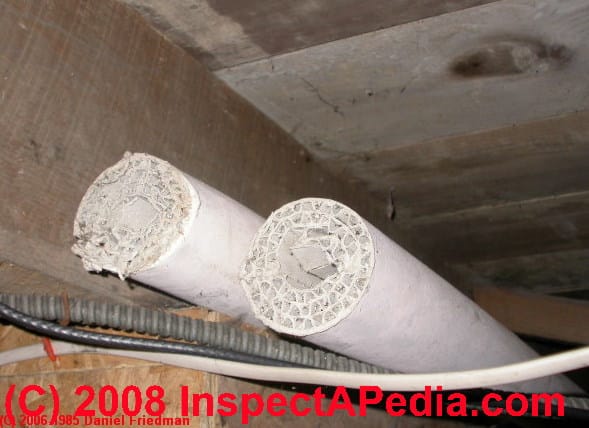 @InspectApedia DF, how do the asbestos wrap appear like? like a kind of rough paper? 2023-12-18 by Anonymous
@InspectApedia DF, how do the asbestos wrap appear like? like a kind of rough paper? 2023-12-18 by Anonymous
Reply: pipe insulation usually has some texture to the surface and not completely smooth
@Anonymous,
Above in this article, you can see examples of different types of pipe wrap, some with asbestos.You can see from those photos, that there is usually some texture to the surface and not completely smooth.
This can, of course, vary depending on the type of wrap, its age, its condition, etc.
Follow up:
@InspectApedia DF, i can see it but, itself won't feel like something that is smooth as painted right? even it is in good condition.
is it soft to touch? is this paint a kind of encapsulation method?
Reply:
@Anonymous,
Typically it's a cloth or fabric wrap that is then painted. So it would feel and look like a stiff fabric.
As we noted in our previous comment to you the covering material used by an asbestos mitigation company might vary. In some cases we've seen a hard plastic enclosure.
Is this modern pipe insulation or asbestos?
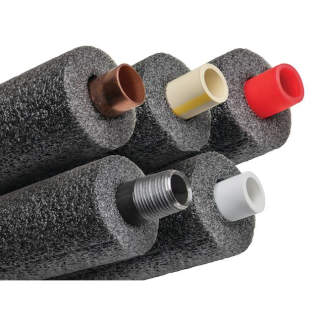
Are these modern pipe insulations? I saw them in the store i worked. 2023-11-20 by Anonymous
Reply:
@Anonymous,
Your photo shows foam insulation on several different kinds of pipe, each wrapped in foam insulation. That's not asbestos.
Is asbestos pipe insulation still produced and used in the U.S.?
is it still being produced and used today in US? what is wet-applied and pre-formed (molded) asbestos pipe insulation. 2023-11-18 by Anonymous
Reply: No. Definition of wet-applied and pre-formed asbestos pipe insulation
@Anonymous,
Look at the photo at the top of this page for typical "pre-formed" corrugated paper like asbestos pipe insulation. That material was simply snapped around or sleeved over a pipe.
Molded paste-like or plaster-like insulation that contained asbestos was formed in place and used at irregular surfaces such as pipe elbows, and often to cover the body of valves and often to cover the exterior of heating boilers. Some texts refer to that material as asbestos lagging or pipe lagging. Lagging (and chrysotile asbestos) are cited in the page above.
"Wet applied" asbestos containing strips or sheets of material were widely used in special applications as well, such as in forming or repairing combustion chamber liners in oil or gas fired boilers and furnaces. You won't see this product unless you are given view inside of the combustion chamber of a heater.
Like the corrugated paper asbestos pipe wrap, if asbestos paste or plaster molded in place pipe lagging is intact, undamaged, in good condition, it is not harmful.
Hessian backed hair felt product
I'm fairly confident this is just hair felt on a hessian backing but it would be good to have it confirmed that it's not asbestos related. Thanks. 2023-10-17 by David Samways
Reply:@David Samways,
I agree with you if that's certainly doesn't look like an asbestos product
1968 France home with white fiberglass pipe insulation
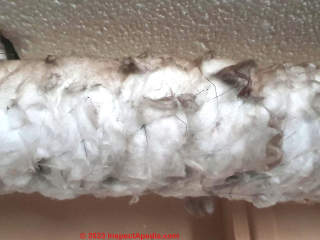
Hello, thank you for your work. Here is a picture of a pipe insulation which I suspect to be asbestos. It is a house we plan to buy. What do you think about it ? Thanks a lot. 2023-10-05 by Christophe
Reply:
@Christophe,
In your photos I see what looks like an inner insulating material of white fiberglass with a "skin" that appears to be a painted fabric.
What are the age and location of the building where this piping is installed?Follow up:
@InspectApedia DF, other pictures
...
...
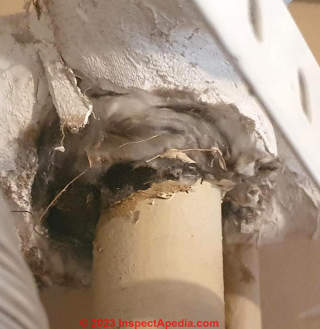
Follow up:
@InspectApedia DF, Thank you very much for your reply. The house was built in 1968. The pipes are in 3 rooms. I will send you more photos. Do you advise me to do an analysis?
...
...
Reply:
@Christophe,
This photo looks like some retrofit covering over an insulating material that we can't see; no one can with certainty rule in or out asbestos without knowing more or testing the material,
But most of your photos show fiberglass insulation, some with a plastic mesh net holding it in place - a rather modern product, and in turn covered by a painted or coated fabric.
That isn't likely to be asbestos, but the age of your U.S. home (1960's) means that asbestos could have been used as pipe insulation at some point in its life.
If you can leave the material alone, undisturbed, and it's not friable, and not being damaged, then there's not likely to be a meaningful asbestos hazard.
If the material is in poor shape or falling apart or must be disturbed, then it would make sense to test a representative sample or two before disturbing it.Follow up:
@InspectApedia Publisher, Thank you very much for your advise. We live in France, where asbestos has been often used until 1997. From this date, it has been forbidden. Have a nice day.
Reply:
@Christophe,
Merci; d'accord - le pays fait tous le diference!
Daniel
Can you identify this insulation inside the walls of a metal B-Vent Chimney?
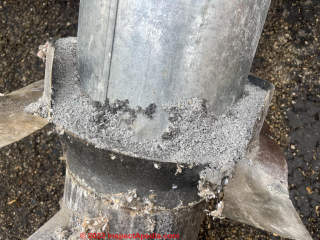
Can you identify this insulation? It was in between the walls of b vent that was used for a gas fireplace. The house is in Wisconsin and was built in 1961.
The b vent was removed as part of a renovation and the insulation was released during removal and I became concerned it could be hazardous. 2023-09-27 by Peter
...
Reply: lining insulation in an older insulated metal flue might contain asbestos
@Peter,
Thank you for the helpful photos and question about the lining insulation in an older insulated metal flue.
I can't identify the material from the photo alone - it's texture is unfamiliar.
IF you know or can find the chimney brand and model that would be very helpful - look for labels or embossed text on the chimney sections.
IF you knew that the chimney was bought after 1986 that would argue against asbestos.
Otherwise to be safe you need to treat the material as presumed to contain asbestos - or if you face a costly cleanup, have a sample tested.Follow up:
@InspectApedia DF, thanks for the insights. I could not determine the manufacturer or age of the chimney so I had it tested. It came back as no asbestos detected (90% glass fibers, 10% non fibrous material).
Reply:
@Peter,
Thanks for the follow-up, that will certainly help other readers with similar insulated chimneys that for some reason are being cut apart.
If you're ever able to find a brand or any other identifying markings on the chimney that would be most useful and would let us do more research.
Is a small hairline dent worrisome on a asbestos plaster on pipe?
is a small hairline dent worrisome on a asbestos plaster on pipe?
is the plaster like paste only used on irregular shape? is it friable?
does this corrugated wrap comes with different size?mine was on a furnace straight pipe, seems to be smaller than those appear on the photo, it was covered under a heavy, thick, and firm coating that looks very new.i moved in 2009, these existed before i moved in.
@InspectApedia Publisher, sorry for bunch of questions, but please answer them it helps a lot. one last question, is the asbestos on pipe friable? will the small damages like dents release fibers on its own without disturbances?
it was covered by some sort of thick and firm white paint, have it is in very good condition, looking new too. it also have a smooth surface. feels hard when touching on it. i am not sure if it is encapsulated wrap or plaster, it is on a straight pipe.
i was worried because i live in that basement for 4 years. i was told the pipe was not damaged at all by the time i stepped in, the dent appeared at a later time.
so is it friable? i don't see the answers. 2023-09-01 by Anonymous
(Ed. note - a number of this reader's comments were combined here)
Reply: No, a "small hairline dent" in asbestos pipe insulation is not likely to be a concern
@Anonymous,
If your "small hairline dent" is the same as my idea of that sort of damage, my answer would be no.
Put another way, if asbestos- or asbestos-suspect pipe insulation is undamaged, that is, it's not shedding insulating material, then it's not releasing a meaningful enough amount of material to be considered a risk, even though asbestos itself is a hazardous material.Follow up: is plaster friable?
@InspectApedia Publisher, thank you, that help a lot, but i still want to know if the plaster is friable or not?
Reply: you must weigh Hazard vs. Risk before spending your money or getting sick from worry
@Anonymous,
InspectApedia exists to be helpful to others and to do so without bias or conflict of interest.
So we want to help you, Anonymous but
with all due respect, you seem to be asking a blizzard of questions without ever reading what we ask you to read. When we point to an article it's because we know that there you will not only find a thoughtful answer to a question but because in the articles here we take time and trouble to research the question and give information that has a proper balance between noticing that something **might** be harmful and understanding when we need to do something about it - and when not.
That is, one needs to balance risk management lest we throw money wildly into wind while actually placing ourselves at greater risk from something more important that we have ignores.
As a simple example, you are thousands of times more likely to be badly hurt by falling down stairs than by walking past a pipe that is insulated with or painted with something that might have contained asbestos.
Please read HAZARD vs RISK where we try to explain this problem.
and help us be more helpful to you by posting there your reaction to and suggestions for the information we explain there.Plaster is not "friable" - you can't make it into fine airborne dust with mere pressure of a thumb.
You’ve already answered your own question in one of your comments.
You said “…it was covered by some sort of thick and firm white paint, have it is in very good condition, looking new too. it also have a smooth surface. feels hard when touching on it…”
And we’ve also said, “…if it's not shedding insulating material, then it's not releasing a meaningful enough amount of material to be considered a risk…”
Friable definition: "easily crumbled between your fingers". If you use the Search box on any of our pages, and do a search for “friable”, you will find MANY articles discussing this topic.
Hopefully you’ve read our Hazard vs. Risk article that we cited in our last response to you - now found above on this page in the Reader Q&A section. You may need to clear or refresh your browser cache to see the updated page.
Thanks
DanielFollow up:
@InspectApedia DF, i thought it was the paint that made it nonfriable. so my question is just if the plaster itself is friable or not.
Reply:
@Anonymous,
Friable definition: "easily crumbled between your fingers". If you use the Search box on any of our pages, and do a search for “friable”, you will find MANY articles discussing this topic.Follow up:
@InspectApedia Publisher, is it possible that it was a encapsulant that made it non friable and smooth, i was told the plaster itself was friable.
Others told me the plaster itself is soft and friable, so i am not sure if there could be something like encapsulant that makes it non friable
Is the plaster itself soft and friable?
Reply: is plaster friable?
Anon:
Think about the definition of "friable" that we've discussed quite a bit, now - can you really pulverize a plaster wall into thin light dust simply using your thumb and forefinger?
If you want more detail about plaster and its properties, please read
PLASTER INGREDIENTS, MIX, PROPERTIES
Follow up: (multiple questions from this reader are listed below)
is the ability of asbestos encapsulant to make asbestos insulation encapsulated in a hard and smooth texture distinguish it from normal paint?
do encapsulation coating comes with different white color depending on the what products? like bright white or off white?
i mean the encapsulant can make the asbestos wrap feels hard and steady. while normal paint can't.
is there different size of corrugated wrap depends on the size of the pipe?
i have a straight pipe insulation coveted in heavy coating, can't even see what is inside, but appears to be a bit smaller than the corrugated wrap appeared in your pictures, so just want to know if smaller wrap is possible.
Reply:
@Anonymous,
Certainly.
Is this spiral pipe wrap fiberglass, Hessian or Asbestos?
Any thoughts on this waste found half buried in the garden please? Is it a pipe insulation? Is it fibreglass, Hessian or worse?
It's a tube around 6 feet long with wire wrapped around a corrugated exterior. Thank you. 2023-08-22 by Oz
Reply: Not asbestos: burlap or jute (Hessian) fabric spiral-wound drain line with a water-resistant exterior coating
@Oz,
That looks like a burlap or jute (Hessian) fabric spiral-wound drain line with a water-resistant exterior coating.
Is this white paper duct seal or this black tarry paper with pink insulation asbestos?
Hello, I recently happened to spot this strange looking black type of paper or almost looks like sandpaper on the back side… It has, but looks like pink insulation over it. It’s in my basement. 2023-08-04 by Jennifer
Reply: ductwork shows asbestos paper tape and fiberglass insulation
@Jennifer,
Your photo shows
1. white cloth or paper-like tape on metal ductwork that may well contain asbestos
2. scraps of pink fiberglass insulation kraft paper facing that is brownish paper on one side and asphalt-coated on the interior side (to cause the facing to stick to the fiberglass)
3. Silver conventional duct tape covering some of the asbestos-suspect duct joint tape.Follow up:
@InspectApedia Publisher,
Thanks so much! So is it safe to remove the dark brown blackish stuff? And should I just leave a paper or cloth tape alone?Reply:
@Jennifer,
It should be safe to simply remove the insulation kraft paper facing scraps. If you find that doing so is tearing the asbestos-suspect paper tape, stop and use a simple spray to wet the materials to ease their separation.
Don't make a dusty mess of the tape and you should be ok.
Is this white stuff on my sink trap asbestos?
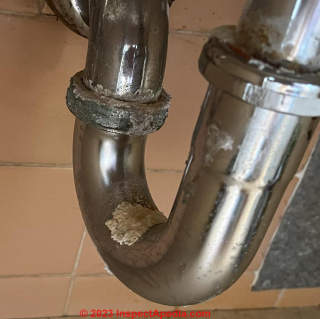
Hi! I've discovered this very helpful site and wonder if you can help me? I'm considering renting a place in San Francisco (it was built in 1945) and want to be sure it has no problems with asbestos or other hazards.
I took this image of the bathroom pipe under the sink (in the part visible to me casually walking through as a tenant, just inside the under-sink cabinet, not inside a wall) and wonder what the putty-like substance is.
Is it possibly asbestos or is it more likely something else? Thank you so much for any guidance you may have! 2023-08-01 by Lynne
Reply: No. Leaky trap corrosion is a mineral deposit, it is not asbestos
@Lynne,
Your photo of a corroded, leaky trap under a sink shows gray-white oxidized metal salts that are deposited when the chrome-plated brass trap material is corroded by water.It is not an asbestos substance.
But your leaky sink trap parts need replacement.
On 2023-07-27 by InspectApedia Publisher
@Conor,
See various pipe insulation materials and identification photos at
PIPE INSULATION CHOICES, MATERIALS, TYPES
On 2023-07-27 by Craig
@InspectApedia Publisher, Thank you!
On 2023-07-27 by InspectApedia Publisher - pipe wrap looks like painted jute
@Craig,
I agree that that pipe wrap looks like a painted cotton or maybe jute fabric but honestly I can't be certain from just the photo.
Where is the building?
On 2023-07-26 by Craig
Home built 1960 - basement refinished at later date. Appears to be a cotton cloth coated with a yellow sealer over cold water pipes to prevent condensation above ceiling tiles. I don't think it is asbestos, but would like another opinion.
The white cloth is soft to the touch where not covered with the yellow paint/sealer. I understand positive/negative confirmation is not possible based on image alone, your opinion on likelihood is appreciated. Thank you.
On 2023-07-26 y InspectApedia Publisher
@Conor,
Something else, perhaps jute.
On 2023-07-26 by Conor
Lagging on copper pipe for radiator, what's the thoughts, asbestos or something else?
On 2023-07-25 by InspectApedia Publisher - attic strut looks to be wrapped in elastic bandage not insulation
@Jarvin,
I agree that the material in your photo looks like an elastic bandage - not something that would be an asbestos insulation product.
I would unwrap it from the wooden member - post another photo of what you see.
Perhaps it was put there to buffer impact after someone bumped their shin, or perhaps simply wrapped by a child.
Let's see what you find.
On 2023-07-25 by Jarvin
Hi, I know this isn't a pipe but I thought this was probably still the best place to ask! I have this wrap around a single wooden roof strut in my attic space. I can't think why you would insulate a strut, but it struck me that it looked a little like it could be some sort of wrap insulation.
The property was renovated in the 1970s. It looks like a bandage to me, but I was concerned it could be some sort of ACM. What do you think? Thanks in advance.
On 2023-07-13 by Anonymous
@InspectApedia Publisher, so does a pipe asbestos encapsulation comes with a color of off-white that appears with a bit of green tone
On 2023-07-13 by InspectApedia Publisher
@Anonymous, thank you for that added detail.
On 2023-07-13 y Anonymous
@InspectApedia Publisher, for the information I only know it was built at 1956 and it was confirmed that asbestos was on the pipe after the removal, but it was encapsulated with sealant, and the color seems to be off-white with a tiny bit of green tone, so I just wanted to know if there is such color for asbestos encapsulation product.
I was doubting that it was not an actual encapsulation because I wasn't sure if there is this kind of color. But As I mentioned before the surface of the paint was smooth, thick, and hard.
On 2023-07-12 by InspectApedia Publisher
@Anonymous,
With respect, I've answered this already to the best of my ability and I'm skeptical that anyone can provide a more useful answer given that we have no actual information about the building concerned or the insulation concerned.
On 2023-07-12 by Anonymous
@InspectApedia Publisher, I can't get a picture of it the homeowner already removed it. So just in general does this kind of asbestos encapsulation comes with different color whether for options or standard
On 2023-07-08 by InspectApedia Publisher
@Anonymous,
It may help to note that painting pipe may or may not have had anything at all to do with a proper asbestos mitigation job. From text, nobody can say more.
Apologies for having to repeat, but with respect, any more comment about this when we can't see the material we are discussing is so speculative as to be of no use.
On 2023-07-08 by Anonymous
@InspectApedia Publisher, I was just wondering if there were this kind of color available for asbestos encapsulation, because there wasn't much information about it when I looked up onto the internet
On 2023-07-07 by InspectApedia Publisher
@Anonymous,
It may help to note that painting pipe may or may not have had anything at all to do with a proper asbestos mitigation job. From text, nobody can say more.
With respect, any more comment about this when we can't see the material we are discussing is so speculative as to be of no use.
On 2023-07-07 by Anonymous
@InspectApedia Publisher, you mean painted the encapsulation or the pipe just don't have encapsulation. The coating was quite thick and have a smooth texture, also in intact
Did you mean the encapsulation appears to be a bit of green is because of the underlying color of the insulation is green?
On 2023-07-07 by InspectApedia Publisher - Is there a standard color for encapsulation coating
@Anonymous,
Depending on just what paint was used to paint pipe insulation it could be any color - thus a potential sign that someone simply painted the pipe.
There is no standard color for paints specifically sold as asbestos remediation encapsulant coatings, but on pipe or pipe insulation, white is most common.
On 2023-07-07 by Anonymous
I have a heating pipe that looks encapsulated, but the color appears to be off-white and a bit green. Is there such color for encapsulation coating?
On 2023-07-06 by InspectApedia Publisher (mod) - Was the use of amosite on heating pipe rare?
@Anonymous,
Please do take a look at the article above where we describe the various forms of asbestos used in insulation and where we start by naming the principal insulating material and asbestos form on heating pipes - that was Chrysotile asbestos.
By definition, once we say that material C was the principal (that is, main or most-often or dominant) material used in an application, any other material would be less common. To try to pin down "less common" to mean "rare" without a quantitative definition of those terms is to slip, trip, and then fall into an asbestos quagmire.
We would sure welcome any suggestions you might have for making that information more clear.
On 2023-07-06 by Anonymous - were other types of asbestos typically be used on furnaces pipe insulation?
Was the use of amosite on heating pipe rare?
@InspectApedia Publisher, also were other types of asbestos typically be used on furnaces pipe insulation in particular setting like larger house with industrial level furnaces rather than normal residential because of their higher heat resistant?
On 2023-07-06 by Anonymous
@InspectApedia Publisher, what i meant was that I just wanted to know if chrysotile was the type of asbestos that people would encounter on furnaces pipe. I already know that any type of asbestos is dangerous.
On 2023-07-06 by InspectApedia Publisher (mod) - knowing which specific asbestos form is in the insulation on pipes or on a boiler etc. does not change what steps or cautions are appropriate.
@Anonymous,
Thanks. I don't mean that the asbestos insulation isn't a potential hazard, I intended to say that knowing which specific asbestos form is in the insulation on pipes or on a boiler etc. does not change what steps or cautions are appropriate.
About the only time I am concerned with identifying exactly which asbestos is present is when a doctor, treating someone, says that information would be helpful.
On 2023-07-05 by Anonymous
@InspectApedia Publisher, thank you for clarifying, i was just confused of you saying that it is moot.
On 2023-07-05 by InspectApedia Publisher (mod) - principally Chrysotile asbestos (white asbestos) was used in pipe insulation and pipe wrap
@Anonymous,
at the start of the article above on this page we state
Chrysotile (white) asbestos
World wide from about 1900 up to the 1970's in the U.S. and into the 1980's in some other countries, asbestos, principally Chrysotile asbestos (white asbestos) was used in pipe insulation and pipe wrap to retain heat in heating and hot water systems and to avoid condensation on cold water supply piping.
Chrysotile is a serpentine (winding or curly fiber) asbestos form that comprised most of the world's asbestos-products.
do let me know if you have suggestions for clarity or other improvements in our article.
Thanks.
DF
On 2023-07-05 by Anonymous
@InspectApedia Publisher, then in general on residential furnaces pipe, what type of asbestos would typically be used? it is just like what you said, the predominant would be chrysotile?
On 2023-07-05 by InspectApedia Publisher (mod) - guessing at which form of asbestos was used shouldn't change what precautions you should follow
@Anonymous,
I appreciate that there has been discussion about which asbestos was used where, but in my OPINION it's moot. While some forms of asbestos are considered more hazardous than others, none of them is safe when disturbed or made into a dusty mess in a home, and the same precautions pertain - they don't vary depending on a lab analysis of just which asbestos type fibers are present.
On 2023-07-05 principally Chrysotile asbestos (white asbestos) was used in pipe insulation and pipe wrap by Anonymous
@InspectApedia Publisher, also how likely that a house built at 1950 NY, that the asbestos on furnaces would be chrysotile rather than other types? was amosite used in residential settings?
On 2023-07-05 by InspectApedia Publisher (mod) - felt pipe insulation (not asbestos)
@Chris,
Your photos look to me like several layers of felt insulation with a fabric external or surface wrap.
On 2023-07-05 by Chris
Adding another picture to my previous post
On 2023-07-05 by Chris
Hi,
I found underneath my suspended floors old pipes with this lagging. Does it seem to you like asbestos or not? The house is build in the 30s and is in England.
Thank you
On 2023-07-05 by InspectApedia Publisher (mod) - Crocidolite (blue asbestos) was used in spray-on insulating coatings
@Strelixias,
From the page above we have this quote:
Crocidolite (blue asbestos) was used in spray-on insulating coatings such as on boilers, steam engines, and sometimes as heating or other pipe insulation.
I would add, however that most heating pipe insulation was the corrugated asbestos paper type for straight runs and more-often we see a past or lagging type asbestos insulation at the elbows and bends of that piping.
On 2023-07-05 by Strelixias
Was Crocidolite typically used as spray on insulation on pipes or as a wrap like chrysotile
On 2023-07-02 by InspectApedia Publisher (mod) - is this asbestos heating pipe insulation?
@Sam,
I'm not sure what that is. It certainly does not match the usual gray corrugated paper form of asbestos pipe insulation which is most common. But just from the photo and the fact that it doesn't look like the usual product isn't enough for me to rule it out.
All that duct tape looks like somebody was trying to cover it up.
To be safe you should avoid making a dusty mess of the material.
On 2023-07-02 by Sam
Is this asbestos? Our home was built in the the 1920s but we rent.
On 2023-05 by InspectApedia Editor (mod)
@Lynda,
Your hairy photo looks like jute or similar insulation.
Your "animal skin" cover, as we see in an enlarged portion of your photo (below) looks like a synthetic fabric, perhaps plastic backed with canvas or cotton.
That's quite odd: hand-stitched. It's as if someone were providing a cover to prevent injury that would occur if a person bumped into a projecting something somewhere in your building.
Where is this 1914 building: country and city?
What sort of mechanical equipment, control, or pipes have been covered?
If that plastic at left in the photo is on the underside of floor joists over a basement or crawl space, that's not the best building practice and it could trap moisture on the "wrong side" of the Barrier. Use housewrap in such locations instead.
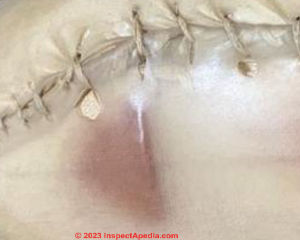
On 2023-05-12 by Lynda
Part 2 to 1914. Pipe covered in what looks like animal skin? Again, looking to see if there is a chance pipe is insulated with asbestos.
On 2023-05-12 by Lynda
Our house is 1914 and we're renovating the basement. We believe pipes are wrapped in animal skin (can't see inside) and then this which looks like burlap and horse. Want to confirm at first look that it is not asbestos.
On 2023-05-12 by InspectApedia Publisher (mod) - foam pipe installation
@Anonymous, Morgan
Yes I agree it sure looks like foam pipe installation
On 2023-05-10 by Morgan
@InspectApedia Editor , Yes, it is in the US. Apologies for leaving that out. Thank you! Any idea what it might be? Foam?
On 2023-05-10 by InspectApedia Editor (mod)
@Morgan,
If your home is in North America, the last year of allowed asbestos use in homes was 1986.
On 2023-05-10 by Morgan
On 2023-05-10 by Morgan
Hopefully, I am being very silly; I am here,
so I’m obviously a cautious person. House was built in 1989.
Had to get to the water shut off today (there is a leak!), and had to go into the first floor living room storage closet to reveal the valve from behind this little wooden hutch covering the valve. However, the piping around the bottom looked weird to me, and I thought I’d ask an expert.
On 2023-04-14 by InspectApedia Publisher (mod)
@patty,
What are looking at ?
An air handler?
Ductwork ?
Building framing?
Spray on material or remnants from spray-on insulation?
Do post more photos, one per comment.
If that's ductwork that's shedding fiberglass, wet, or moldy it's an indoor air quality hazard.
If it's spray-on fire coating it could be an asbestos hazard.
Really we can't tell what's dust, cobwebs, deposits from leaks, or something else from just this one photo.
If there have been leaks there could also be a mold hazard in your home.
Have you seen a doctor?
Have you asked your health department for help?
On 2023-04-14 by patty
I have been at my apt 3 months and before moving in didnt hae these problems but the past 2 months have noticed me and husband who has asthma becoming short of breathe and more tired then usual then tthe last month i been spitting up like lil hair or dust constantly each time i spit in my mouth feels like there is a bunch of tiny hairs i have gotten to the point were i have trouble breathing and the landlord wouldnt look into untill i did myself just to try and change the filter and ran into all this and its way worse then what the picture shows
[Photo above]
On 2023-01-14 by InspectApedia Publisher (mod)
@Kaj,
That looks like a combination of fiberglass and crepe paper.
On 2023-01-14 by Kaj
Is this asbeso? The insulation shine when i use a flashlight on it
On 2022-12-19 by InspectApedia (Editor) (mod) - asbestos scraps left on pipe indicates improper / amateur asbestos abatement job
@Jason,
Thanks for the additional details. I agree that hard surfaces are much-easier to clean of dust of any sort.
Given the signs of an amateur asbestos-removal-job in the first place, keep alert to discover other short-cuts or snafus.
On 2022-12-19 1 by Jason
@InspectApedia (Editor), thanks for the help! Just had a consultation with a removal professional. He wasnt too concerned about contamination, in part because there isnt much left and we dont know how long ago it was removed.
I think it could have been as recent as 2018 when a flipper installed a new boiler but it could have been much older.
Going to have them clean up and paint seal the exposed pipes and add some fiberglass insulation to close up the gap where those pipes that are still covered are sitting.
Also getting a hepa air purifier just as an extra precaution. Our house is all old hardwood floors anways so most dust should have been removed over the years from regular cleaning.
On 2022-12-15 by InspectApedia (Editor) (mod) - how risky are small amounts of asbestos insulation left on pipe?
@Jason,
That photo is almost certainly a left-over scrap of asbestos pipe insulation.
Watch out: my concern when I see incomplete asbestos pipe insulation removal is that it was evidently not a job done by a trained professional - a pro should not leave asbestos in place on pipes like that and often they'll also use an encapsulant paint to lock down any remaining dust at the end of the job.
So the risk is that an amateur asbestos rip-off job may have contaminated the building.
I would:
- look for other examples of this work and if you're finding more of them you might want an onsite evaluation by an asbestos abatement company
- consider collecting 1 or 2 representative samples of settled dust to screen the building to be sure that there is no worrisome asbestos dust contamination that needs to be cleaned-up.
DO NOT PANIC about this - the panic would be a greater health worry than that asbestos scrap.
Do keep me posted.
On 2022-12-15 by Jason
@InspectApedia (Editor), its in eastern pa and the building was listed as 1900s when we bought the home earlier this year. Its impossible to really asses how intact it is without pulling off some old planks underneath.
Our washer and dryer is not far from that space on rhe next floor so i was concerned about dust being kicked around from the vibrations. I also included a second pic of the pipes that likely had the same material removed.
The pipe is only around an inch thick for reference. Are those remaining fragments also a concern?
On 2022-12-15 by InspectApedia (Editor) (mod) - asbestos insulation remnants on pipe
@Jason,
I'm not sure about all the stuff I see in your photo but at least in the upper center that looks like pipe insulation that could be asbestos.
Where is the building and how old is it.
YES leave it alone for now.
Asbestos is safe and legal in buildings as long as it's in good condition and not being disturbed.
On 2022-12-15 by Jason
Any idea what this is? I found it in a small space above the door to my bilco door, around our radiator pipes
. I also notice what looks like fiberous material around more exposed sections of pipes so im wondering if a past owner removed most of it and left this more enclosed section. If so, should we have it removed or left alone?
On 2022-12-03 by InspectApedia (Editor) (mod) - magnesium carbonate asbestos (or not asbestos) pipe insulation
@terrance,
Thanks so much for the photo and Magnesia pipe insulation question. 100% MgCO3 won't contain asbestos but we warn that other products containing the same material did contain asbestos.
See details and your photo at
MAGNESIUM CARBONATE ASBESTOS PIPE INSULATION
On 2022-11-27 by terrance
I have several stickers that say 100 percent magnesium carbonate. Does this mean no asbestos?
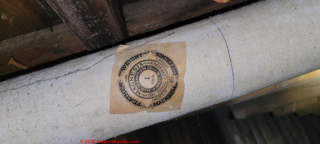
On 2022-11-25 by InspectApedia (Editor) (mod)
@Matthew,
Glad to assist - working together helps us both.
About those possible asbestos remnants, it'd be no surprise to find a few tiny bits of asbestos on piping even after a professional asbestos remediation. On a 1929 home it's likely that asbestos pipe wrap was on the original heating or hot water pipe installation.
In my OPINION a little better job - still possible - is to spray-paint the cleaned, exposed piping so that any remnants are immobilized. There should be no meaningful asbestos hazard from what we're seeing. Of course we don't know what's under that foam but even if it's an asbestos wrap, it looks encapsulated.
On 2022-11-25 by Matthew
@InspectApedia (Editor), uff, I didn't even notice that possible asbestos remains on the pipe, thank you for taking a look at the image and annotating it like that!
On 2022-11-24 by InspectApedia (Editor) (mod) - multiple insulating materials on and around pipe
@Matthew,
There are at least two, maybe three insulating materials that I THINK I can see in your photo, annotated in a copy of your image.
On 2022-11-24 by Matthew
Thank you for all the information on this website, it's been very helpful with getting to grips with the old house we just moved into.
Our house was built in 1929. Recently I had some insulation work done that required the contractors to move a work bench in the basement. In doing so, they revealed the Steam Heat pipe in the picture I've attached.
I'm having trouble telling what sort of insulation it is, it doesn't seem to match any of the photos on your site, do you recognize it at all?
[Photo above]
On 2022-11-18 by InspectApedia (Editor) (mod)
@Kne,
I looked at your photo, even zoomed in, but I can not make out ANY of the actual pipe insulating material. What we see is a fabric wrapped over "something" and sealed at one end with what looks like silver duct tape.
Take a look at the asbestos pipe insulation illustrated above on this page. You can compare that to what you're seeing.
Or perhaps you can add a photo of the end of that wrapped stuff on the pipe so that we might have a better look.
While a lab test is generally required to confirm the identity of asbestos in many materials, SOME asbestos pipe insulation like that shown at the very top of this page is unmistakable since there was not another non-asbestos insulation used on piping and that looks the same.
On 2022-11-17 by Kne
What would be hard packed inside this material wrapped around the pipe? Resembles dark clay almost, holds form, owner says it's not asbestos. House built in 1890. Curious.
On 2022-11-14 by InspectApedia (Editor) (mod) - coarse brown fibers are not asbestos
@Martin,
That coarse brown fibrous material won't be asbestos. It looks a lot like jute or another organic insulating material.
On 2022-11-14 by Martin
Is this possibly asbestos.
On 2022-11-07 by InspectApedia (Editor) (mod) - fiberglass pipe wrap insulation is not asbestos
@Guy,
It looks like fiberglass pipe wrap
On 2022-11-07 by Guy
Wondering if this paper type insulation I took off my pipe in our crawl space is asbestos. I wore a respirator but yeah it was definitely floating around a bit.
Had no choice but to remove and replace the heat shrink underneath.
On 2022-11-01 by InspectApedia-911 (mod) - does liner material inside my hot water convector radiator from the 1930s contain asbestos?
@Grace,
I'm sorry to say that from just your text and photo nobody can make an absolute statement about whether or not the little scrap of paper in that plastic bag contains asbestos or not.
Asbestos in paper and board forms was used in many heating system components and could have been a heat-insulating backer in a heating convector though in that location in thin paper form, it'd have had so little value that I am doubtful.
It would be more-helpful to see a photo of the heating convector unit in-situ, showing that tan paper in-place and in-use, presumably from which your little scrap sample was torn.
While you'd have to have a lab test done to prove for sure that your scrap is just paper not asbestos, you can see photos of what asbestos paper looks-like at
ASBESTOS PAPER DUCT INSULATION
Asbestos was used with thin kraft paper in some insulating products shown for example in this PDF from 1947
inspectapedia.com/insulation/Infra-insulation-1947.pdf
from which the crinkle insulation image below has been excerpted.
Typical heating convector construction and features are described at
WALL CONVECTORS HVAC
also take a peek at
ASBESTOS USE in APPLIANCES
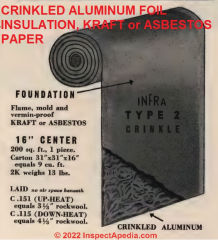
On 2022-10-31 by Grace
I found liner material inside my.hot water convector radiator from the 1930s and an worried if it's asbestos
I was cleaning the fins before turning the heat on for the season and noticed what looked like paper between the fins and the front metal strip that is part of the housing for the fins. the house is super old and these are original radiators so I thought maybe a kid stuck paper in there.
used a flat head screw driver to try and push the paper out but when a chip fell to floor I saw it wasn't paper. the brown side faces the fins and yellow was the v dude attached to metal strip.
Again this liner or whatever it is is from 1930s. I cannot find anyone who. can identify if it had asbestos init not even Trane Hvac businesses.
On 2022-10-25 by InspectApedia (Editor)
@Fabio C,
That looks like fiberglass
On 2022-10-25 by Fabio C
Hi, Wondering if this is asbestos related, it was used to wrap the pipes going from radiatior to radiator. Thanks, Fabio
On 2022-10-07 by InspectApedia-911 (mod)
@James Durley,
Yellowish material is almost certainly fiberglass. It looks like there's some white stuff on the fiberglass but I can't quite make that out.
On 2022-10-07 by James Durley
Hi. I wonder if this is Asbestos. I saw this in someone's loft. It was wrapped around an old oil boiler flue. Someone has bagged the flue up and left in a void within the house. There is a picture zoomed into some that I can see on the floor in the void. The picture of the flue is hard to see but I didn't want to take out of the wrapping. Thanks.
On 2022-10-03 by InspectApedia-911 (mod) - white corrugated paper-like material is probably asbestos pipe insulation
@Steve Schultz,
The white corrugated-paper-like material in your photo is probably asbestos pipe insulation.
The yellow material is probably fiberglass.
On 2022-10-03 by Steve Schultz
I know that I have some old radiator pipes wrapped in asbestos, but would like confirmation that the other insulation with the yellow coloring is not asbestos.
Also I am assuming the yellow colored powder is most likely fiberglass and not asbestos. Can someone confirm this for me? I am attaching 2 images (I think).
On 2022-10-11 by InspectApedia (mod)
@Saddie,
It is not a friable material, so even if it contains asbestos you'd be hard-pressed to detect a hazardous asbestos fibre or dust release from such a product under normal conditions.
DOES THIS MATERIAL CONTAIN ASBESTOS? - 5 easy questions to tell if a BUILDING MATERIAL probably contains asbestos
https://inspectapedia.com/hazmat/DIY-Asbestos-Material-Test.php
can help you provide more contextual information that addresses the asbestos question.
On 2022-10-10 by Saddie
@InspectApedia , definitely not friable then. but I do see it was cut into in this and one more spot. based on the age and location of the house - do you think it contains asbestos?
On 2022-10-10 by InspectApedia (mod) - if not friable, there is little asbestos concern
@Saddie,
Friable means easily crumbled between your fingers, i.e. easy to make into a dust or small particles.
On 2022-10-10 by Saddie
@InspectApedia-911, the house was built in 1969, suburbia of Chicago. Hope this helps. When you say friable - what exactly do you mean?
On 2022-09-30 by InspectApedia-911 (mod) - stick on wrap type pipe insulation
@Saddie,
That looks like a stick on wrap type pipe insulation. One cannot save from the photo whether or not it contains asbestos. But it would be useful to know the age and location of the building and a guess at the age of the wrap on material.
In any case if it is that the sticky type pipe wrap, it's not friable.
On 2022-09-30 by Saddie
When we moved in the inspector was not sure if this wrap was asbestos. I really would appreciate your input because my kids are starting to play more on that area and I need to know if it’s safe.
On 2022-09-25 by InspectApedia (Editor)
@MM
Thanks for the question and photo - sorry, but no we cannot assert that the pipe insulation in your photo is asbestos.
That dark gray material is not familiar to us. Comparing it with the asbestos pipe insulation on the page above we don't see a resemblance
It may be a cellulose material.
Short of an asbestos lab test, a sharp-focused close-up might allow us to offer a more-interesting opinion.
On 2022-09-25 by InspectApedia (Editor)
Re-posting from private email:
MM asked:
Are you able to identify the attached photo of the following as asbestos?
[Sent from the UK - Ed.]
On 2022-08-19 by InspectApedia-911 (mod) - pipe insulation looks newer
@Max,
That looks like a rather new wrap on those pipes, possibly covering old pipe insulation and yes that older insulation may contain asbestos, though I can't see enough to have a confident opinion.
It would be helpful to know the country and city of location of the building and the building age.
On a 1908 house it's quite likely that asbestos pipe insulation would have been used on heating pipes and sometimes on water pipes too.
It's also plausible that a prior owner had asbestos pipe insulation either removed, or some removed and some encapsulated.
Your pipe wraps looked pretty new, hence my prior opinion.
Sometimes a careful inspection can find evidence of (incomplete) asbestos insulation removal - bits left at elbows and in hard-to-access areas such as where pipes head up into ceiling or wall cavities or down into enclosed floor cavities.
On 2022-08-19 by Max
Could you please help us identify if the pipe insulation containing asbestos? The house was build in 1908 in Chicago. The previous owner did a full renovation in ~2000. I dont' see any other (old) materials between the pipe and new wrap material.
On 2022-08-12 by InspectApedia (mod)
@Anonymous,
Your photo is showing two different brands of and colors of fiberglass insulation.
On 2022-08-12 by Anonymous
1969 Cardinal Camper, I'm unsure if asbestos comes in a yellow fiber texture. The pink in the photo is new standard insulation. The yellow is what I'm unsure about.
On 2022-08-08 by InspectApedia-911 (mod) - powdery substance is likely UFFI in a circa 1914 house
@Dan,
Looks like UFFI foam.
Read the description
at UFFI, HOW TO IDENTIFY in BUILDINGS
On 2022-08-08 by Dan
I'm wondering about this powdery substance that was used to insulate heating pipes in a circa 1914 house. It is powdery with fine, soft particles. The house is from around 1914 and this is powdery; pieces easily rub/break off and turn to dust. Is that likely to happen with foam insulation. Seems more like a fine sawdust, but not quite.
On 2022-08-02 by InspectApedia-911 (mod) - corrugated asbestos paper with an external wrap or skin
@Aaron,
That's not animal fiber.
Almost certainly it's corrugated asbestos paper with an external wrap or skin.
I'd like to see a better photo in which you use a flash so that you can light up the end of the insulating material.
But you can certainly compare it with the photo shown here.
This is one of the few materials that can be reliably identified by visual inspection as asbestos corrugated paper because there was no look alike product that looks exactly the same but that was not an asbestos material.
On 2022-08-02 by Aaron
So our boss claims he tested this pipe wrap and it came back as animal fiber. I have a very hard time trusting this guy and at this point call b.s....... His only concern is everybody works. I feel he is putting the whole crew at risk requesting it to be removed. The home in question was built in 1929 in N.C. And the insulation is a wrap around boiler pipes.
I included a image I snapped today. Would I be in the wrong to remove a sample and have it tested it myself? I’m no expert but I have concerns on the material.
On 2022-07-06 by InspectApedia-911 (mod) - balsam wool insulation
@Andrew,
That brown fibrous insulation is almost certainly a Balsam wool product. That's a wood fiber, not asbestos, a mineral.
On 2022-06-28 by Andrew
First, thank you so much for this wonderful resource!
I'm looking for help identifying the insulation in this image. House was built in ~1950 in Michigan. Unknown if this section of cast iron sewer pipe is original, although we believe it is. This is the main sewer line descending from the first floor of the house into the basement.
It looks like balsam wool to me, but wanted a second opinion. Thanks!
On 2022-06-19 by InspectApedia-911 (mod) - fiberglass and common fiberglass /plastic/paper/foil wraps
@Anonymous
OK so on a house that old certainly there could have been any number of asbestos-containing products, including drywall and joint compound visible in one of your photos.
But the pipe insulation in your photos looks like fiberglass and common fiberglass /plastic/paper/foil wraps.
Take a look at ASBESTOS PIPE INSULATION - the article above on this page
We've posted your photos and question (received by private email) on this page for you to see and to invite comment from others.
Note that asbestos fibres may be found in old mastic adhesives - as you've read, though that material is not normally friable so doesn't release particles to the air except if disturbed such as by demolition.
Note that asbestos could well be in drywall and joint compound and possibly in a foundation waterproofing paint in your home, depending on the age of those materials.
And of course asbestos was used in thousands of other products.
That's not a reason to be frightened. It's a reason to avoid disturbing suspect materials, cover them, or if there must be demolition, then use appropriate procedures.
On 2022-06-19 by InspectApedia-911 (mod) - can there be some asbestos fibers mixed into this insulation?
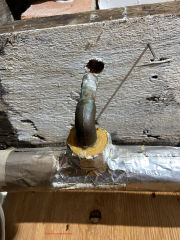 Re-posting from private email:
Re-posting from private email:
Anonymous reader says -
First of all, I wanted to thank you immensely for your wonderful database. I'm grateful for all the wonderful information your provide. I truly can't thank you enough!
Secondly, I would like to seek your help regarding identifying the material in the three photos I've attached to this email. They're all pipe insulation found in my basement around regular (mostly) copper water supply pipes. I'm concerned about the insulation itself but also the white paper or plastic wrap that is also degraded and being reinforced with packing and/or aluminum tape.
The bit that concerns me most is the most damaged insulation around the pipe coming right out of the water meter. They may have been added at different times.
I suspect it's all fiberglass and the tape or casing is plastic or paper but perhaps it's asbestos or asbestos containing material. I'm no expert and I'm not sure about the oldest bit by the water meter in particular. We only bought the house a year ago. I also know from some research that even the fiberglass insulation can have asbestos in it:
...
This is simply black mastic or whatever you call it and I don't see that in the insulation in my house, though I've not torn it to look underneath so I can't be sure.
What I'm wondering is whether there can be some asbestos fibers mixed into this insulation especially the bit by the water meter, independent of any black mastic. I've lost count of all the things asbestos fibers were added to and perhaps this fiberglass insulation is among them. ...
I would very much appreciate your help with this matter since we have upcoming renovations next week or the one after that will involve this section of the basement. - Anonymous 2022/06/16
Follow-up:
The house was built in 1912 but, of course, there have been several renovations over the years in bits and pieces so to speak. It's a two-story, two-bedroom house. It's located in Toronto, Ontario, Canada.
On 2022-06-18 by InspectApedia-911 (mod) - cellulose insulation
@Steve,
Looks like cellulose. Take a closer look for bits of newsprint.
On 2022-06-18 by Steve
House was built in 1945 and expanded in 1970. Found some of this on a hot water pipe. Black plastic over filling which may or may not be asbestos.
On 2022-06-13 by InspectApedia-911 (mod)
@Jim,
That brown and white coarse fibrous material is far more likely to be jute or hemp insulation and fiberglass or similar product.
On 2022-06-12 by Jim
Hi found this wrapped around radiator pipes inside wall while removing radiator.
is it possible asbestos?
On 2022-06-13 by Andrew
@InspectApedia-911, Thank you for your thorough answer! Much appreciated for taking the time - it is really helpful.
On 2022-06-10 by InspectApedia-911 (mod)
@Andrew,
Please find our discussion now at the reader Q&A found at
HEMP / JUTE INSULATION
Post added photos, questions, comments as you wish.
Thank you for the discussion.
On 2022-06-10 by InspectApedia-911 (mod) - does reader need to worry about mixed fibers in insulation
@Andrew,
With a dissemblance that nowhere nearly matches the level of ducking and weaving in U.S. politics today, I note that I'm inspecting your insulation through the pinhole of a few photos - nowhere nearly as accurate as on-site or from a sample in our forensic laboratory.
But to me from your photos the material does not look like fiberglass or mineral wool.
PLEASE take a look at our insulation identification discussion, description, and photos found in the INSULATION IDENTIFICATION GUIDE - home - given in the list of Recommended Articles on this page.
There you can make additional visual comparisons.
Fiberglass and mineral wool don't look like plant fibres in colour, translucency, nor smoothness of the fibres.
--
I can't say what someone might possibly do or not about mixing insulation products but we don't normally find Jute mixed with asbestos nor fiberglass in simple jute insulating wraps for pipes. Doing so flies in the face of the reasons given for the production of that insulation in the first place.
BUT a more fact-based answer can be found by a judicious search of patent disclosures and technical articles.
For example see
K Arun Prasath and B Radha Krishnan, MECHANICAL PROPERTIES OF WOVEN FABRIC BASALT/JUTE FIBRE REINFORCED POLYMERHYBRID COMPOSITES [PDF] Int. J. Mech. Eng. & Rob. Res. 2013, ISSN 2278 – 0149 www.ijmerr.com
Vol. 2, No. 4, October 2013 - retrieved 2022/06/10, original source: http://www.ijmerr.com/v2n4/ijmerr_v2n4_34.pdf
Abstract:
Composites are emerging as realistic alternatives to the metal alloys in many applications like
automobiles, marine, aerospace applications, sports goods, etc. Fiber composites offer many
advantages such as low specific gravity, tensile strength and modulus, compressive strength
and modulus, better fatigue strength, etc.
Due to the low specific gravity the strength weight ratio and modulus weight ratio of these composite materials are markedly superior to those of metallic materials. In this work it is concerned general purpose poly ester-based polymer composites are developed by reinforcement of basalt fabric and jute fabric into general purpose poly ester matrix by compression moulding technique.
This study describes the basalt fiber and jute fibre reinforced hybrid composites with poly ester resin with different stacking sequence. Fabricated composite plates subjected to mechanical properties like Flexural strength, Impact strength test of the various specimens are calculated by using computer assisted Universal testing machine and Charpy Impact testing machine.
From the results it is found that pure
basalt fibre combination maintains higher values in both flexural and tensile test. But for impact
test basalt fibre is slightly lower than jute fibre reinforced composite.
You will read that this polymer-reinforced jute appears to be more of a specialty product than low-cost pipe-wrap such as that in your photos.
---
I would not lose a nanosecond's of sleep worrying about an environmental hazard from a bit of jute insulation that fell into a ceiling cavity.
But I would ask and investigate why it fell off: is there a moisture problem or rodent problem that raises other concerns? Is there a freeze risk concern? Is there an energy cost concern?
On 2022-06-10 by Andrew
@InspectApedia-911,
Thank you very much for your answer – It’s really helpful! It seems as some kind of fibre indeed.
If you don’t mind I would have a few more questions:
1. Based on the pictures do you think we can exclude mineral wool/rock wool and/or fibreglass, too?
2. Could the insulation on the pictures be some kind of a fibre combined with mineral wool or fibreglass?
3. It seems fibre-particles of the insulation came off and there are under the pipes – do you think it is problematic if these particles fall down from the concealed ceiling into our apartment (through the inspection hatches)?
Thank you again!
Andrew
On 2022-06-06 by InspectApedia-911 (mod) - jute insulation not asbestos
@Andrew,
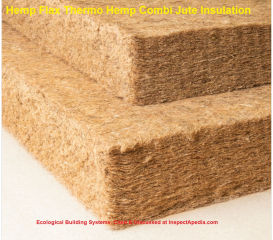 That's not asbestos insulation - it looks like jute (hemp-flax insulation) or a similar fibre.
That's not asbestos insulation - it looks like jute (hemp-flax insulation) or a similar fibre.
Illustrated here are batts of hemp flax thermo-hemp insulation as distributed in the UK by https://www.ecologicalbuildingsystems.com/ described by the vendor as "Manufactured using discarded cocoa and coffee bean bags."
See details and compare your insulation with
HEMP / JUTE INSULATION https://inspectapedia.com/insulation/Jute-Insulation.php
and let me know what you think.
On 2022-06-06 by Andrew
Asbestos insulation?
On 2022-06-08 by InspectApedia-911 (mod)
@David wild,
If you're referring to that brown fibrous stuff in the center of your photo that looks like fiberboard. Typically a wood product.
On 2022-06-08 by David wild
Hi this is behind my fuse box, house is circa 1960 I'm unsure whether it's wood or hopefully not asbestos board. It has suffered from what looks like woodworm but is in poor condition.
...
Continue reading at ASBESTOS PIPE INSULATION - topic home, or select a topic from the closely-related articles below, or see the complete ARTICLE INDEX.
Or see these
Recommended Articles
- ASBESTOS in GOOD CONDITION
- ASBESTOS in POOR CONDITION
- ASBESTOS REMOVAL, AMATEUR
- ASBESTOS on HEATING BOILERS
- ASBESTOS TESTING LAB LIST
- CEMENT ASBESTOS PIPE MANUFACTURE
Suggested citation for this web page
ASBESTOS PIPE INSULATION FAQs3 at InspectApedia.com - online encyclopedia of building & environmental inspection, testing, diagnosis, repair, & problem prevention advice.
Or see this
INDEX to RELATED ARTICLES: ARTICLE INDEX to ASBESTOS HAZARDS
Or use the SEARCH BOX found below to Ask a Question or Search InspectApedia
Ask a Question or Search InspectApedia
Try the search box just below, or if you prefer, post a question or comment in the Comments box below and we will respond promptly.
Search the InspectApedia website
Note: appearance of your Comment below may be delayed: if your comment contains an image, photograph, web link, or text that looks to the software as if it might be a web link, your posting will appear after it has been approved by a moderator. Apologies for the delay.
Only one image can be added per comment but you can post as many comments, and therefore images, as you like.
You will not receive a notification when a response to your question has been posted.
Please bookmark this page to make it easy for you to check back for our response.
IF above you see "Comment Form is loading comments..." then COMMENT BOX - countable.ca / bawkbox.com IS NOT WORKING.
In any case you are welcome to send an email directly to us at InspectApedia.com at editor@inspectApedia.com
We'll reply to you directly. Please help us help you by noting, in your email, the URL of the InspectApedia page where you wanted to comment.
Citations & References
In addition to any citations in the article above, a full list is available on request.
- In addition to citations & references found in this article, see the research citations given at the end of the related articles found at our suggested
CONTINUE READING or RECOMMENDED ARTICLES.
- Carson, Dunlop & Associates Ltd., 120 Carlton Street Suite 407, Toronto ON M5A 4K2. Tel: (416) 964-9415 1-800-268-7070 Email: info@carsondunlop.com. Alan Carson is a past president of ASHI, the American Society of Home Inspectors.
Thanks to Alan Carson and Bob Dunlop, for permission for InspectAPedia to use text excerpts from The HOME REFERENCE BOOK - the Encyclopedia of Homes and to use illustrations from The ILLUSTRATED HOME .
Carson Dunlop Associates provides extensive home inspection education and report writing material. In gratitude we provide links to tsome Carson Dunlop Associates products and services.


